#i love drawing 2D characters on 3D scenarios
Text

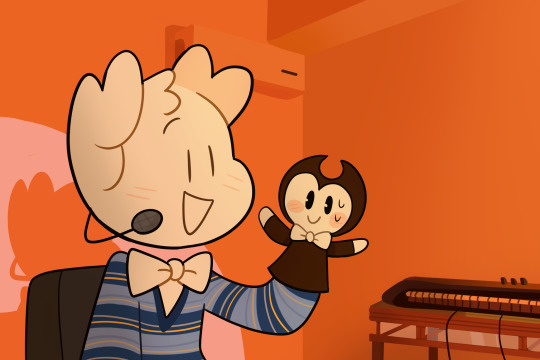



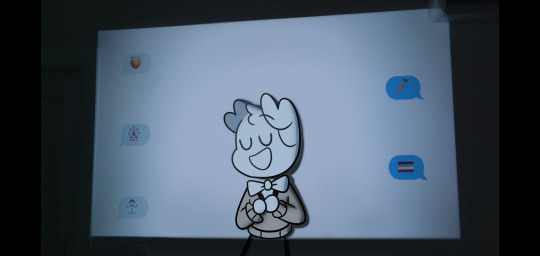
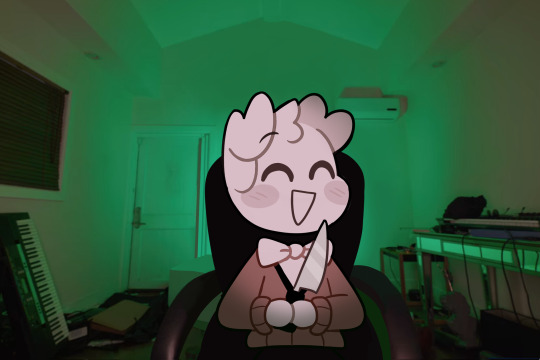

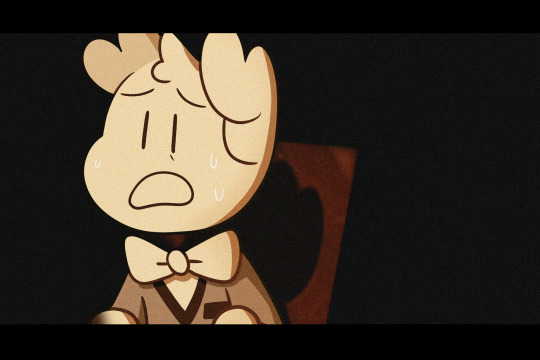

INSIDE- but i drew Spring where Bo was supposed to be LMAO
Honestly, this was a great way to practice backgrounds, lighting and colors!
Happy 3rd anniversary to this special! (i know it was on the 29th but i forgot💀)
🏠🚪
PLEASE DO NOT REPOST MY ART
#i love drawing 2D characters on 3D scenarios#it’s a guilty pleasure of mine#my artwork#<3<3<3#bo burnam inside#my sona#i drew A LOT of scenes but these are enough…for now ^^
219 notes
·
View notes
Photo
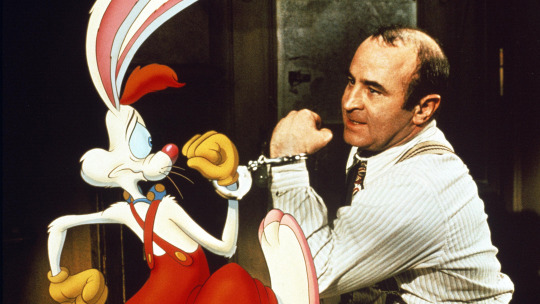
Blurring the Line.
As a new Space Jam film beams down to Earth, Kambole Campbell argues that a commitment to silliness and a sincere love for the medium is what it takes to make a great live-action/animation hybrid.
The live-action and animation hybrid movie is something of a dicey prospect. It’s tricky to create believable interaction between what’s real and what’s drawn, puppeteered or rendered—and blending the live and the animated has so far resulted in wild swings in quality. It is a highly specific and technically demanding niche, one with only a select few major hits, though plenty of cult oddities. So what makes a good live-action/animation hybrid?
To borrow words from Hayao Miyazaki, “live action is becoming part of that whole soup called animation”. Characters distinct from the humans they interact with, but rendered as though they were real creatures (or ghosts), are everywhere lately; in Paddington, in Scooby Doo, in David Lowery’s (wonderful) update of Pete’s Dragon.
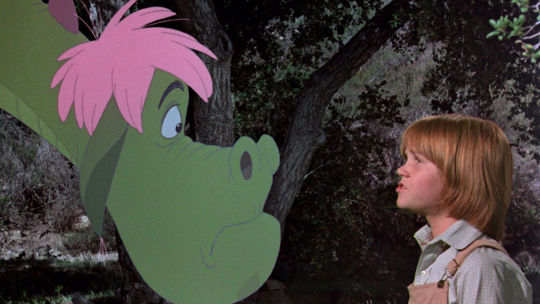
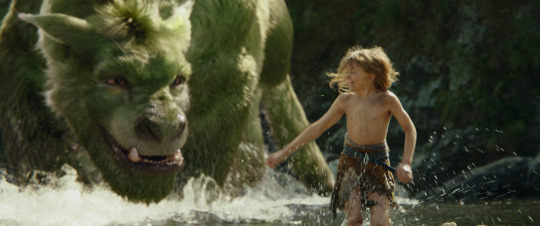
The original ‘Pete’s Dragon’ (1977) alongside the 2016 remake.
Lowery’s dragon is realized with highly realistic lighting and visual-effects work. By comparison, the cartoon-like characters in the 1977 Pete’s Dragon—along with other films listed in Louise’s handy compendium of Disney’s live-action animation—are far more exaggerated. That said, there’s still the occasional holdout for the classical version of these crossovers: this year’s Tom and Jerry replicating the look of 2D through 3D/CGI animation, specifically harkens back to the shorts of the 1940s and ’50s.
One type of live-action/animation hybrid focuses on seamless immersion, the other is interested in exploring the seams themselves. Elf (2003) uses the aberration of stop-motion animals to represent the eponymous character as a fish out of water. Ninjababy, a Letterboxd favorite from this year’s SXSW Festival, employs an animated doodle as a representation of the protagonist’s state of mind while she processes her unplanned pregnancy.
Meanwhile, every Muppets film ever literally tears at the seams until we’re in stitches, but, for the sake of simplicity, puppets are not invited to this particular party. What we are concerned with here is the overlap between hand-drawn animation and live-action scenes (with honorable mentions of equally valid stop-motion work), and the ways in which these hybrids have moved from whimsical confections to nod-and-wink blockbusters across a century of cinema.

Betty Boop and Koko the clown in a 1938 instalment of the Fleischer brothers’ ‘Out of the Inkwell’ series.
Early crossovers often involve animators playing with their characters, in scenarios such as the inventive Out of the Inkwell series of shorts from Rotoscope inventor Max Fleischer and his director brother Dave. Things get even more interactive mid-century, when Gene Kelly holds hands with Jerry Mouse in Anchors Aweigh.
The 1960s and ’70s deliver ever more delightful family fare involving human actors entering cartoon worlds, notably in the Robert Stevenson-directed Mary Poppins and Bedknobs and Broomsticks, and Chuck Jones’ puntastic The Phantom Tollbooth.

Jerry and Gene dance off their worries in ‘Anchors Aweigh’ (1945).
Mary Poppins is one of the highest-rated live-action/animation hybrids on Letterboxd for good reason. Its sense of control in how it engages with its animated creations makes it—still!—an incredibly engaging watch. It is simply far less evil than the singin’, dancin’ glorification of slavery in Disney’s Song of the South (1946), and far more engaging than Victory Through Air Power (1943), a war-propaganda film about the benefits of long-range bombing in the fight against Hitler. The studio’s The Reluctant Dragon (1941) also serves a propagandistic function, as a behind-the-scenes studio tour made when the studio’s animators were striking.
By comparison, Mary Poppins’ excursions into the painted world—replicated in Rob Marshall’s belated, underrated 2018 sequel, Mary Poppins Returns—are full of magical whimsicality. “Films have added the gimmick of making animation and live characters interact countless times, but paradoxically none as pristine-looking as this creation,” writes Edgar in this review. “This is a visual landmark, a watershed… the effect of making everything float magically, to the detail of when a drawing should appear in front or the back of [Dick] Van Dyke is a creation beyond my comprehension.” (For Van Dyke, who played dual roles as Bert and Mr Dawes Senior, the experience sparked a lifelong love of animation and visual effects.)
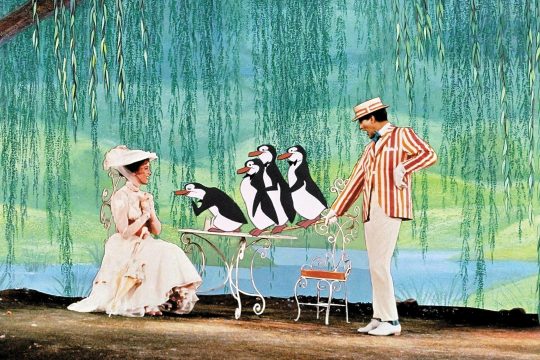
Julie Andrews, Dick Van Dyke and penguins, in ‘Mary Poppins’ (1964).
Generally speaking, and the Mary Poppins sequel aside, more contemporary efforts seek to subvert this feeling of harmony and control, instead embracing the chaos of two worlds colliding, the cartoons there to shock rather than sing. Henry Selick’s frequently nightmarish James and the Giant Peach (1996) leans into this crossover as something uncanny and macabre by combining live action with stop motion, as its young protagonist eats his way into another world, meeting mechanical sharks and man-eating rhinos. Sally Jane Black describes it as “riding the Burton-esque wave of mid-’90s mall goth trends and blending with the differently demonic Dahl story”.
Science-classroom staple Osmosis Jones (2001) finds that within the human body, the internal organs serve as cities full of drawn white-blood-cell cops. The late Stephen Hillenburg’s The Spongebob Squarepants Movie (2004) turns its real-life humans into living cartoons themselves, particularly in a bonkers sequence featuring David Hasselhoff basically turning into a speedboat.
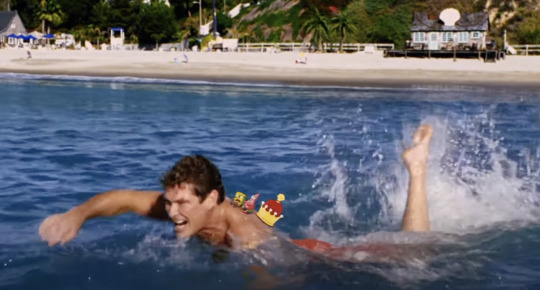
David Hasselhoff picks up speed in ‘The Spongebob Squarepants Movie’ (2004).
The absurdity behind the collision of the drawn and the real is never better embodied than in another of our highest-rated live/animated hybrids. Released in 1988, Robert Zemeckis’ Who Framed Roger Rabbit shows off a deep understanding—narratively and aesthetically—of the material that it’s parodying, seeking out the impeccable craftsmanship of legends such as director of animation Richard Williams (1993’s The Thief and the Cobbler), and his close collaborator Roy Naisbitt. The forced perspectives of Naisbitt’s mind-bending layouts provide much of the rocket fuel driving the film’s madcap cartoon opening.
Distributed by Walt Disney Pictures, Roger Rabbit utilizes the Disney stable of characters as well as the Looney Tunes cast to harken back to America’s golden age of animation. It continues a familiar scenario where the ’toons themselves are autonomous actors (as also seen in Friz Freleng’s 1940 short You Ought to Be in Pictures, in which Daffy Duck convinces Porky Pig to try his acting luck in the big studios).

Daffy Duck plots his rise up the acting ranks in ‘You Ought to Be in Pictures’ (1940).
Through this conceit, Zemeckis is able to celebrate the craft of animation, while pastiching both Chinatown, the noir genre, and the mercenary nature of the film industry (“the best part is… they work for peanuts!” a studio exec says of the cast of Fantasia). As Eddie Valiant, Bob Hoskins’ skepticism and disdain towards “toons” is a giant parody of Disney’s more traditional approach to matching humans and drawings.
Adult audiences are catered for with plenty of euphemistic humor and in-jokes about the history of the medium. It’s both hilarious (“they… dropped a piano on him,” one character solemnly notes of his son) and just the beginning of Hollywood toying with feature-length stories in which people co-exist with cartoons, rather than dipping in and out of fantasy sequences. It’s not just about how the cartoons appear on the screen, but how the human world reacts to them, and Zemeckis gets a lot of mileage out of applying ’toon lunacy to our world.
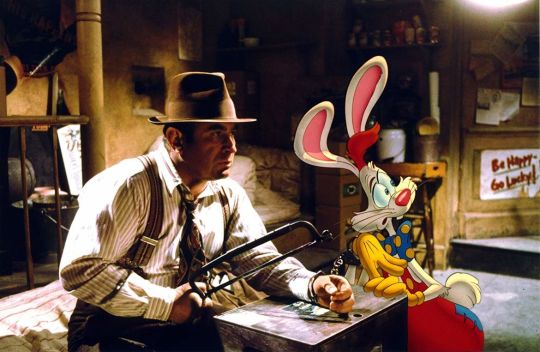
Bob Hoskins in ‘Who Framed Roger Rabbit?’ (1988).
The groundbreaking optical effects and compositing are excellent (and Hoskins’ amazing performance should also be credited for holding all of it together), but what makes Roger Rabbit such a hit is that sense of controlled chaos and a clever tonal weaving of violence and noirish seediness (“I’m not bad… I’m just drawn that way”) through the cartoony feel. And it is simply very, very funny.
It could be said that, with Roger Rabbit, Zemeckis unlocked the formula for how to modernize the live-action and animation hybrid, by leaning into a winking parody of what came before. It worked so perfectly well that it helped kickstart the ‘Disney renaissance' era of animation. Roger Rabbit has influenced every well-known live-action/animation hybrid produced since, proving that there is success and fun to be had by completely upending Mary Poppins-esque quirks. Even Disney’s delightful 2007 rom-com Enchanted makes comedy out of the idea of cartoons crossing that boundary.
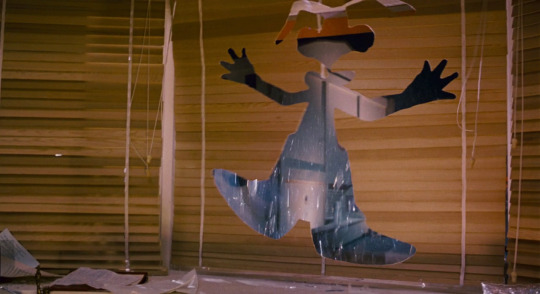
When a cartoon character meets real-world obstacles.
Even when done well, though, hybrids are not an automatic hit. Sitting at a 2.8-star average, Joe Dante’s stealthily great Looney Tunes: Back in Action (2003) is considered by the righteous to be the superior live-action/animated Looney Tunes hybrid, harkening back to the world of Chuck Jones and Frank Tashlin. SilentDawn states that the film deserves the nostalgic reverence reserved for Space Jam: “From gag to gag, set piece to set piece, Back in Action is utterly bonkers in its logic-free plotting and the constant manipulation of busy frames.”
With its Tinseltown parody, Back in Action pulls from the same bag of tricks as Roger Rabbit; here, the Looney Tunes characters are famous, self-entitled actors. Dante cranks the meta comedy up to eleven, opening the film with Matthew Lillard being accosted by Shaggy for his performance in the aforementioned Scooby Doo movie (and early on throwing in backhanded jokes about the practice of films like itself as one character yells, “I was brought in to leverage your synergy!”).
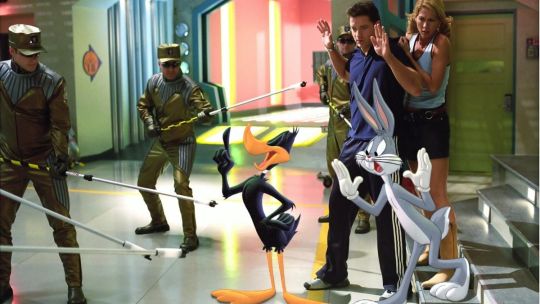
Daffy Duck with more non-stop banter in ‘Looney Tunes: Back in Action’ (2003).
Back in Action is even more technically complex than Roger Rabbit, seamlessly bringing Looney Tunes physics and visual language into the real world. Don’t forget that Dante had been here before, when he had Anthony banish Ethel into a cartoon-populated television show in his segment of Twilight Zone: The Movie. Another key to this seamlessness is star Brendan Fraser, at the height of his powers here as “Brendan Fraser’s stunt double”.
Like Hoskins before him, Fraser brings a wholehearted commitment to playing the fed-up straight man amidst cartoon zaniness. Fraser also brought that dedication to Henry Selick's Monkeybone (2001), a Roger Rabbit-inspired sex comedy that deploys a combo of stop-motion animation and live acting in a premise amusingly close to that of 1992’s Cool World (but more on that cult anomaly shortly). A commercial flop, Back in Action was the last cinematic outing for the Looney Tunes for some time.
Nowadays, when we think of live-action animation, it’s hard not to jump straight to an image of Michael Jordan’s arm stretching to do a half-court dunk to save the Looney Tunes from slavery. There’s not a lot that can be fully rationalized about the 1996 box-office smash, Space Jam. It is a bewildering cartoon advert for Michael Jordan’s baseball career, dreamed up off the back of his basketball retirement, while also mashing together different American icons. Never forget that the soundtrack—one that, according to Benjamin, “makes you have to throw ass”—includes a song with B-Real, Coolio, Method Man and LL Cool J.
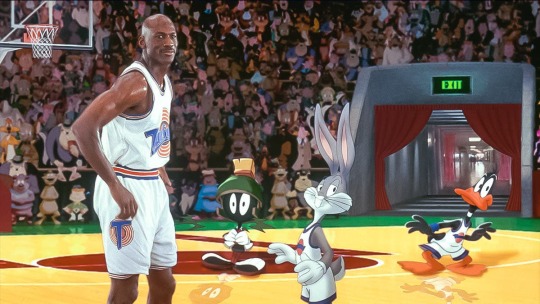
Michael Jordan and teammates in ‘Space Jam’ (1996).
Space Jam is a film inherently born to sell something, predicated on the existing success of a Nike commercial rather than any obvious passion for experimentation. But its pure strangeness, a growing nostalgia for the nineties, and meticulous compositing work from visual-effects supervisor Ed Jones and the film’s animation team (a number of whom also worked on both Roger Rabbit and Back in Action), have all kept it in the cultural memory.
The films is backwards, writes Jesse, in that it wants to distance itself from the very cartoons it leverages: “This really almost feels like a follow-up to Looney Tunes: Back in Action, rather than a predecessor, because it feels like someone watched the later movie, decided these Looney Tunes characters were a problem, and asked someone to make sure they were as secondary as possible.” That attempt to place all the agency in Jordan’s hands was a point of contention for Chuck Jones, the legendary Warner Bros cartoonist. He hated the film, stating that Bugs would never ask for help and would have dealt with the aliens in seven minutes.
Space Jam has its moments, however. Guy proclaims “there is nothing that Deadpool as a character will ever have to offer that isn’t done infinitely better by a good Bugs Bunny bit”. For some, its problems are a bit more straightforward, for others it’s a matter of safety in sport. But the overriding sentiments surrounding the film point to a sort of morbid fascination with the brazenness of its concept.

Holli Would (voiced by Kim Basinger) and Frank Harris (Brad Pitt) blur the lines in ‘Cool World’ (1992).
Existing in the same demented… space… as Space Jam, Paramount Pictures bought the idea for Cool World from Ralph Bakshi as it sought to have its own Roger Rabbit. While Brad Pitt described it as “Roger Rabbit on acid” ahead of release, Cool World itself looks like a nightmare version of Toontown. The film was universally panned at the time, caught awkwardly between being far too adult for children but too lacking in any real substance for adults (there’s something of a connective thread between Jessica Rabbit, Lola Bunny and Holli Would).
Ralph Bakshi’s risqué and calamitously horny formal experiment builds on the animator’s fascination with the relationship between the medium and the human body. Of course, he would go from the immensely detailed rotoscoping of Fire and Ice (1983) to clashing hand-drawn characters with real ones, something he had already touched upon in the seventies with Heavy Traffic and Coonskin, whose animated characters were drawn into real locations. But no one besides Bakshi quite knew what to do with the perverse concept of Brad Pitt as a noir detective trying to stop Gabriel Byrne’s cartoonist from having sex with a character that he drew—an animated Kim Basinger.
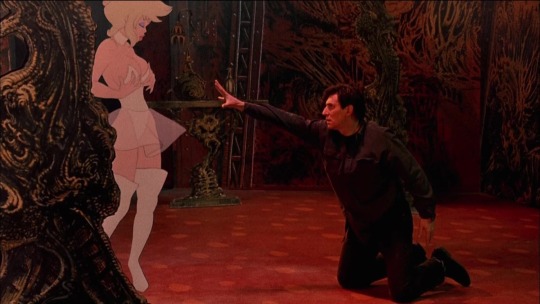
Jack Deebs (Gabriel Byrne) attempts to cross over to Hollie Would in ‘Cool World’ (1992).
Cool World’s awkwardness can be attributed to stilted interactions between Byrne, Pitt and the animated world, as well as studio meddling. Producer Frank Mancuso Jr (who was on the film due to his father running Paramount) demanded that the film be reworked into something PG-rated, against Bakshi’s wishes (he envisioned an R-rated horror), and the script was rewritten in secret. It went badly, so much so that Bakshi eventually punched Mancuso Jr in the face.
While Cool World averages two stars on Letterboxd, there are some enthusiastic holdouts. There are the people impressed by the insanity of it all, those who just love them a horny toon, and then there is Andrew, a five-star Cool World fan: “On the surface, it’s a Lovecraftian horror with Betty Boop as the villain, featuring a more impressive cityscape than Blade Runner and Dick Tracy combined, and multidimensional effects that make In the Mouth of Madness look like trash. The true star, however, proves to be the condensed surplus of unrelated gags clogging the arteries of the screen—in every corner is some of the silliest cel animation that will likely ever be created.”
There are even those who enjoy its “clear response to Who Framed Roger Rabbit”, with David writing that “the film presents a similar concept through the lens of the darkly comic, perverted world of the underground cartoonists”, though also noting that without Bakshi’s original script, the film is “a series of half steps and never really commits like it could”. Cool World feels both completely deranged and strangely low-energy, caught between different ideas as to how best to mix the two mediums. But it did give us a David Bowie jam.
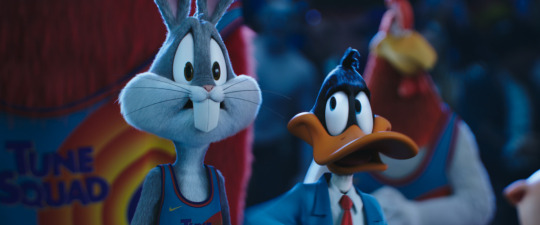
‘Space Jam: A New Legacy’ is in cinemas and on HBO Max now.
Craft is of course important, but generally speaking, maybe nowadays a commitment to silliness and a sincere love for the medium’s history is the thing that makes successful live-action/animation hybrids click. It’s an idea that doesn’t lend itself to being too cool, or even entirely palatable. The trick is to be as fully dotty as Mary Poppins, or steer into the gaucheness of the concept, à la Roger Rabbit and Looney Tunes: Back in Action.
It’s quite a tightrope to walk between good meta-comedy and a parade of references to intellectual property. The winningest strategy is to weave the characters into the tapestry of the plot and let the gags grow from there, rather than hoping their very inclusion is its own reward. Wait, you said what is coming out this week?
Related content
Rootfish Jones’s list of cartoons people are horny for
The 100 Sequences that Shaped Animation: the companion list to the Vulture story
Jose Moreno’s list of every animated film made from 1888 to the present
Follow Kambole on Letterboxd
#kambole campbell#mary poppins#ralph bakshi#hayao miyazaki#ghibli#disney#who framed roger rabbit#roger rabbit#spongebob squarepants#spongebob#animation#live action animation#live action animation hybrid#stop motion animation#stop motion#wes anderson#brad pitt#bob hoskins#genre#space jam#space jam a new legacy#michael jordan#lebron james#looney tunes#bugs bunny#daffy duck#warner bros#2d animation#letterboxd
25 notes
·
View notes
Text
Borderlands Foam Wig Tutorial (Tyreen)
I was chatting with the lovely @void-noises-exe and it eventually circled around to offering to make a wig tutorial because you don’t see too terribly many, just thought I’d throw mine out ( especially because It was next to impossible to find good references of a foam version of Ty’s hair.) So this will be for foam wigs in general but Tyreen’s hair specifically (with a few pics of my Fiona wig from tales as well because they better accentuate my points) I didn’t plan on making this so I am missing a few pictures that might be helpful but here we go. This will not be short.
Supplies:
-Craft foam (ideally, in small and XL sheets, but you can make do with whatever size you have available)
- Spray paint as close to the BASE color of the wig you need (for Ty I used white, for Fiona a medium brown) ideally in a matte.
- a FUCKLOAD of paints (i use cheap acrylics from the craft store ) in Black, and then several shades of the colors in the hair. (For Fiona i used i think four browns? Tyreens shaved sides have three browns, and the top had an additional yellow-brown i mixed) try to vary them in darkness levels to add depth.
- multiple paint brushes. I like to use around four or five of varying sizes and hardness levels.
- plenty Hot glue, and a hot glue gun (note: you COULD use other typres of adhesive, I like hot glue because its got great hold on foam, it sets FAST and worst case scenario I can take a hair dryer to it and melt it again if I need something to be undone.)
- scissors
- duct tape
-plastic wrap
-sharpie
-wig head
-Plenty of reference images
(optional supplies include a rotary cutter and or exacto-knife [trust me, itll make your life so much easier] , and patience. )
SO to start
1) Put your hair in a wig cap or however you plan on wearing it under your wig. Wrap your whole hair bit of your head in plastic wrap. Make sure you get over your ears and the baby hairs on your neck if you want to keep them.
2) Wrap all the plastic covered bits in duct tape. This is easier for a friend to do on you, but not impossible to do alone, just make sure to get it all. It should be snug. Make sure you get as far down the back of your neck and down your sideburn area as you can. (Most characters have a bit of fringe hanging down in the back so its not the BIGGEST concern for them, but Ty’s got nada so you’re gonna want some good coverage for your hair line.)
3) Take your sharpie and draw an outline of where your ear is, and along the hairline you’d like your wig to have. For short haired characters you dont want to cut too far behind the ear or your hair will peek out, so I like to underestimate how big my ear is and adjust as needed later. Dont make your wig hairline too high either, particularly if you’re making a wig for a character who has no fringe in the front.
4) Take that bad boy off and cut along your outlines. Try it on again, adjust lines as needed. rinse and repeat.
5) once you reach a semi-accurate mold of your head, you’re gonna wanna take it off and cut AT LEAST 4 (front, back, and both sides (I like to do 8, it will lay flatter) sections,coming to a point at the crown of your head. It should come out looking something like this. NOTE : they’re all still connected in the middle. If you’re doing 8, cut each of these 4 in half. )
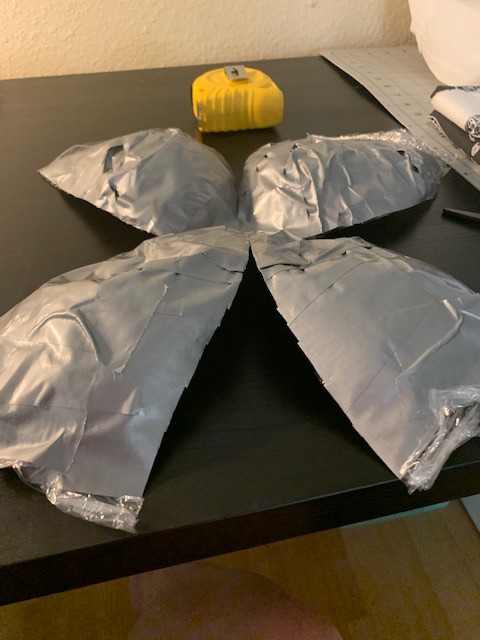
6) Lay out your foam beneath this. If you dont have a piece of foam big enough to trace this bad boy onto, what I do is literally just break out the hot glue gun a bit early, glue a couple pieces together along the edges, until i get a nice big connected surface. Trace this guy on there as accurately as you can, cut it out, and then glue all your sides together. Now you should have a foam version of your duct tape hat.

(Dont worry if the sides wont stay down, if you’re doing a character like Ty where thats an issue, we’ll get to that part later. )
7) (Optional but VERY helpful) Grab your wig head, and your duct tape head. Tape the duct tape back together and put something in it to make it hold shape, I use poly-fil. Tape the head-form to the wig head, and put your little foam cap on top of that.
8) Time to get creative. You’re gonna want to start from the bottom layers first. For Tyreen that’s the long fringe and her undercut. The strategy I decided on was to take a few large rectangular strips of foam, and lay them out everywhere I wanted the undercut to be and cut along the edges to match the hairline. I don’t have a picture of this exact point in the process but I have one from the beginning of the next step. Really the only thing to note at this point is obviously, your head is round and rectangles are not, for the curves where it sticks up along the edges, cut down where it sticks up in a little triangle and hot glue the ends together (you can sort of see this at the top left in the picture below). Dont worry about seams at this point, we’ll hide them later.

9) This was not the case for Fiona who has very flat hair ( especially because of her hat) but Tyreen has a lot of volume especially towards the front of her head. For hair pieces that need volume, such as the ones that are glued down here, cut two of the exact same foam piece (i like to do them in little waves like the side, but also just a little arch is good for volume without flips such as the front piece) and glue the matching edges together. Make sure the hair triangle is facing the way youd like it to! Then Flatten out the top as much as you can, the bottom will keep the volume and the top ill be able to be covered by “2D” hair pieces.
(NOTE: Honestly, it’s REALLY difficult to end up with an exact copy of cannon, and I ALLLLWAYS get carried away with the spikes. In the end, go by your reference images, but also follow your heart. Cosplay is half about having fun creating. )
10) Once youve started gluing, make sure to keep in mind where your part is (if you have one). For Fiona i didn’t trust myself so I glued in the hair at the part BEFORE anything, and left them ready to be glued down while I worked my way up to them.
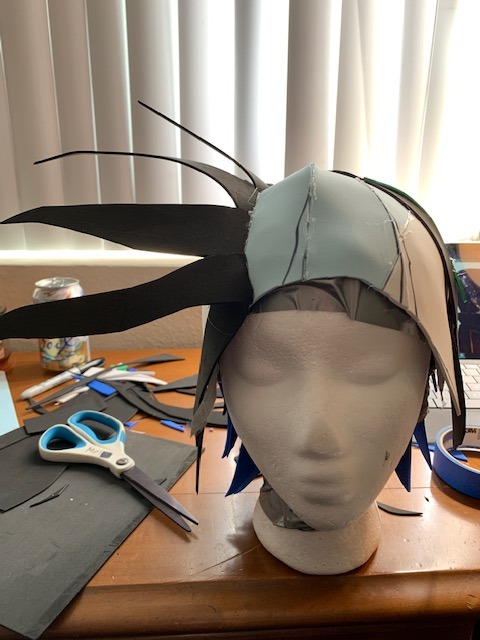
NOTE: All the hair at the parts of BOTH wigs is a single piece of foam.You want a nice wide base whenever possible to cover up the seams of all of the other edges of the hair. For your part, Carefully glue along the very end of your strip of foam and stick it down. It will be the last piece to be glueddown on top of everything else to make it look nice and clean.
11) Slowly start working your way around the head, gluing down first anything that will need to be covered (3D pieces and bottom pieces) before getting towards the top where youll need to be more strategic about what is going down and what can cover your edges. I’d definitely recommend mixing 2D and 3D pieces if that’s something you want to experiment with, otherwise, such as in the pic below, it is possible to get volume from a 2D piece, simply by gluing it in a way where it wont lie flat against the head.
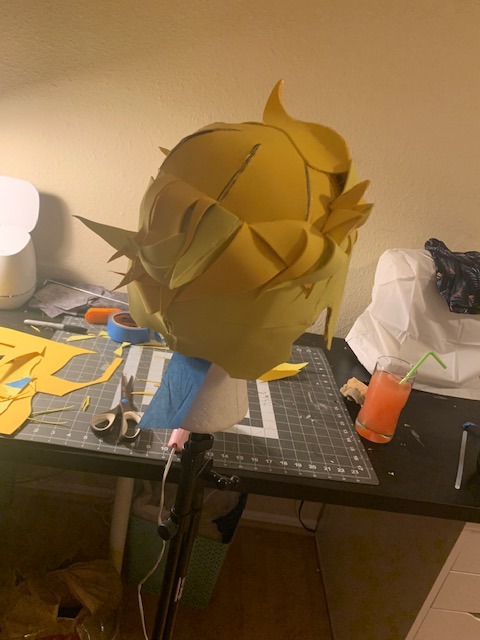
12) in the picture above you can also catch a glimpse of Ty’s cow lick. Those are done exactly the same as our 3D pieces from before, only you trace the edges of the open end, and should end up with a triangular third side to be glued in, then just glue along the edges just like the hair part.
13) Dont feel you have to overdo how many pieces the hair has, remember you may also paint in pieces and designs when it comes to the line-art!
14) Once you’ve added everything from the bottom that you’d like to, go ahead and glue down your hair-part.


15) So, obviously, I wasn’t a big fan of Tyreen’s undercut just being flat foam across half my head. So I took an exacto to it for what felt like years. REALLY over-do it on the edges, it’ll get rid of that harsh foam line and give it a little more of a natural blend. Also pay special attention to all of your seams in the foam. The more distressing there is there, the less youll be able to spot lines later.

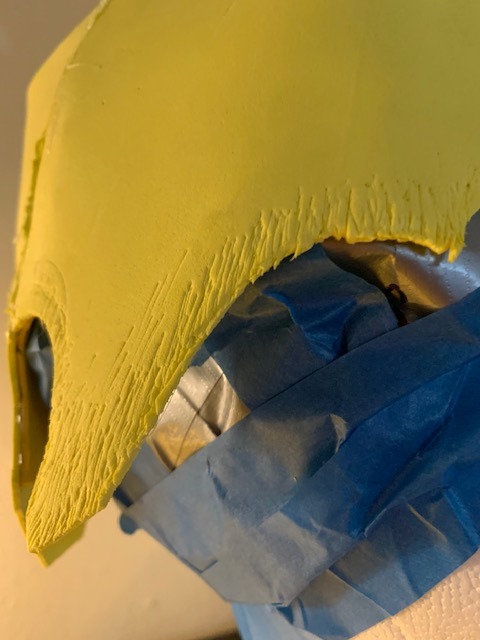
16) So once you have the overall structure of your wig and you’re thinking you might be happy with this, its spray paint time. (I’d recommend disposable gloves for this, you’re gonna need to maneuver it every which way to get the pain in every cranny and that paint does NOT like to come off easy.) Theres really not much advice I can offer on it, just be patient, and do a couple layers, spray it from every angle and let it dry completely before moving on to the next step unless youre as impatient as I am and dont mind ruining a few paintbrushes.
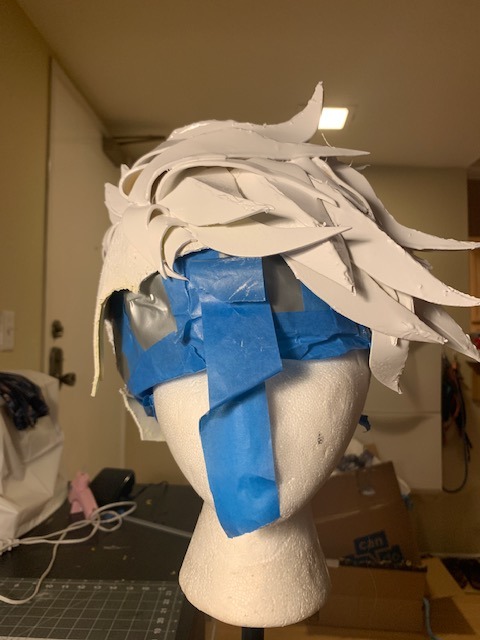
17) So, like the Fiona pic a few back or this one here, you should have a fairly flat evenly painted foam sculpture. Now is around the time you might start seeing all the inaccuracies in what you’ve made. You gotta push past that it’ll look great I promise. Time to get really creative.
18) for Ty I started by painting the buzzed bits in a base brown, and started in on the line art and her roots while i waited for it to dry before going in with two more colors of brown for depth.
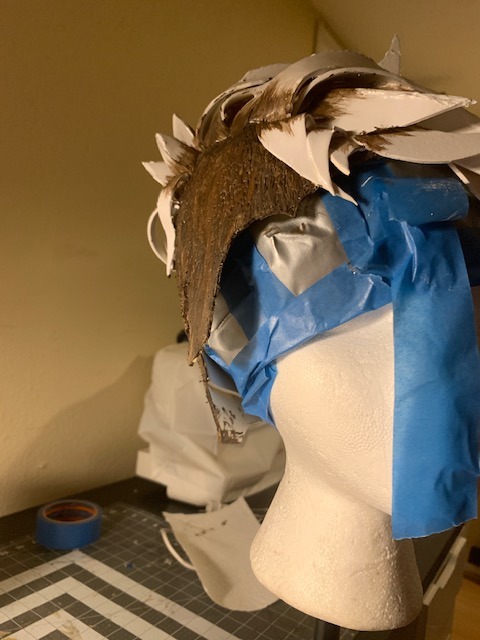
19) For her roots I ended up using three colors. Black at the very bottom (which blends into the line art) a dark brown that matches more or less the buzz, and then after the fact, a custom yellowed-brown to blend better into the white and give us a little more texture. For this and the rest of the cel-shading in the hair, dab your brush before painting and try to mostly stick to light strokes in one direction (OR: if you have one, a particularly hard bristled paint brush does wonders for this) you don’t want the ends of your strokes to be too defined.
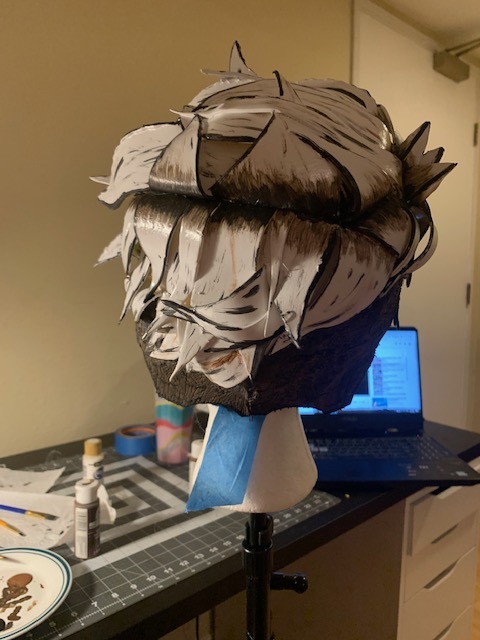

20) Outline the edges of the hair and all prominent pieces, particularly the hot-glue seams, itll make them less noticable. (dont forget the little animation squiggles for Ty’s sides) and beyond that-- honestly, black out to your hearts content. These pics are from when I thought I’d finished. I really felt I’d over detailed. The next day I looked at a picture and realized there is always WAY more texture and outlining than I feel like I see. Honestly, you cant really over-do it, especially with fine solid black lines.
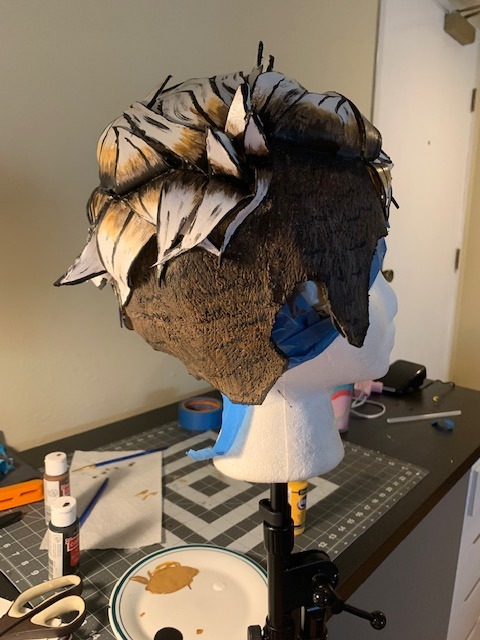
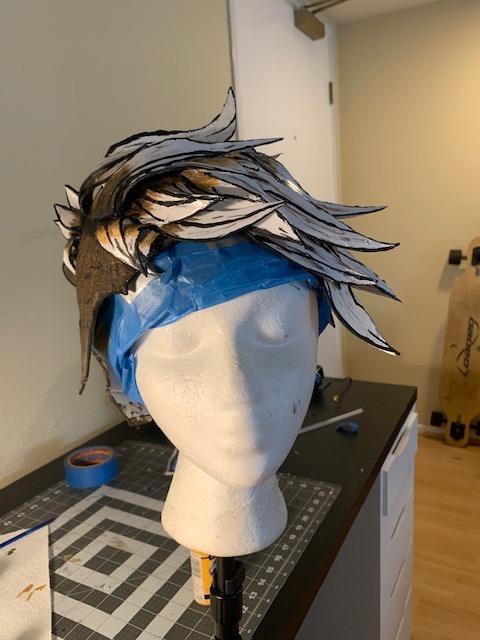
21) The next day I came back at it with the yellowed-brown and LOTS more solid black lines. (Currently in the process of taming down where I got too excessive with the spikes on the side)
22) Once it’s all dried, time to try on. Here’s where we address if you have a short haired character, and the edges of your wig just wont stay down -- invest in a little theatrical grade spirit gum. It’s not too terribly expensive, and unfortunately, I tried the cheaper halloween makeup kind, and it just wont hold how you need it too (and please for my sake, also make sure you get spirit gum remover) I took some hair gel (you could also use elmers glue) just to glue up as much of my hair as I could on the sides and the back of my neck to keep them from the spirit gum, and dabbed it along all of the prominent edges of the wig (namely, side and back) wait for it to get a little tacky and stick that MF-er down good.
Aaaaand Voila???
Let me know if I missed any steps? Its fairly simple, once you get going -- just time consuming.
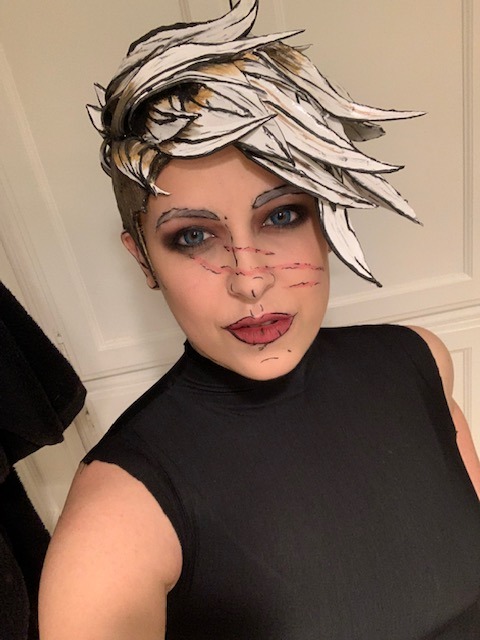
58 notes
·
View notes
Text
My Three Page Pseudo-Essay on How the Kirby Anime Would/Should Be Made Today
This was written due to @hedeservesbetter tagging my post with “i woukd [sic] love to read this[, Akira]”.
Let me start off by saying there is a little more to this essay than what the original post says. We’re going to touch a number of topics not listed in it, but those are my biggest ideas. Let’s all also note the I don’t hate the Kirby anime. People accused me of hating the anime or trying to make it edgy the last time I made a post like this, and I still don’t understand why. It’s my favorite anime, probably. If it isn’t, it’s up there with Paranoia Agent and Perfect Blue as one of my favorites. Also note that the two “main” versions of the anime (Japanese and English) blend together in my head, and I’ll talk about both of them as though they are the same (because, honestly, you’re kidding yourself if you think they aren’t), but if I need to specify the version, I’ll use their full titles (Kirby of the Stars and Kirby: Right Back at Ya, respectively).
To say that nearly any animation that was made before the late 2000’s wouldn’t be better if it were made today is lying to yourself. There is so much technology we have today that we didn’t have before then. There’s a very big chance that if the Kirby anime was made today, it could be 100% 2D animation instead of half-3D like it was. That’s only possible because of programs like Flash or Toon Boom, which allow 2D animations to be made easier and faster. Most of the reason that characters like Kirby or King Dedede were animated in 3D half the time was to cut costs and development time. It’s hard to draw so many perfect circles and curved lines almost the exact same on every consecutive frame, but this downside is entirely negated by the use of digital animation tools, which allow you to copy shapes from one frame to the next. My sentiments seem to be echoed exactly by the development staff on the anime. Here’s a quote from Yoshikawa Souji (director and a writer on the anime), translated by Ivyna J. Spyder:
“3D is a way to increase the number of frames. If you make a 3D model once, then you are able to make efficient use of that. [...] [I]f it’s 3D, because you make a model, you can make movement from just clicking it.
“Therefore, the animator doesn’t have [a] hard time with drawing and can instead devote their time to movement, and it’s easy to get information of production and camera. [...] Already, it has 3-5 times the movement of normal TV anime.”
There’s also the option of it being a 100% 3D anime, like its 3DS-exclusive short, Kirby 3D. Being made only in 2012, the 3D already looks so much more competent. Of course, I can also point to the many fully-3D cutscenes that have been in Kirby games since then, the best-looking being the ones in Kirby: Star Allies. It’s very obvious that Nintendo has been becoming more competent with its 3D animations and models very quickly, considering their almost company-wide switch to 3D games, as opposed to 2D. Even with a television budget, ignoring the fact that Nintendo and HAL have infinite money to throw at anything they wish, this could still happen. A lot more fully-3D cartoons and anime have been popping up lately, including the visually gorgeous Land of the Lustrous and Miraculous Ladybug.
God, that’s a lot of words to just be talking about animation. And I haven’t even gotten to the part I started this essay to write! Let’s get on with that, shall we?
Escargoon is my favorite character in the Kirby anime, and right now, is my favorite character of all time. While that’s always subject to change, I suspect he’ll always be in the top ten. Anyone who knows anything about me knows I love this guy. I’ve even gotten others who don’t even know of the Kirby anime to love him.
Which makes me infuriated that he’s treated so badly.
You may have noticed I didn’t mention a certain penguin king in that sentence, even though he’s the one most associated with torturing Escargoon. But the truth is everyone, even the anime itself, seems to love to torture him. I don’t get it! I like the gay snail! I think he’s neat! And I’m sure at least a few of the writers and animators do too! So why does he get deprived of sleep and basic self care because “Haha, it’s funny to see him obsess over a robot”? Why does he get possessed by Erasem, causing him to go nearly insane from being forgotten by everybody? Why does he get abused by his boss so much it actually unsettles him when he treats him nicely? I don’t get it! I want good things to happen to him. I don’t want to watch him go insane from something out of his control every thirty episodes. Dedede isn’t treated like this, and he’s worse than Escargoon, objectively.
The anime starting with Dedede being nicer to Escargoon is a really, really good way for this issue to be remedied. Not only is the trope of a villain power couple way more interesting than “man in power beats his assistant who is clearly in love with him in Kirby of the Stars and has a choice to leave at any time in both versions, but doesn’t for some reason”, the latter is just unnecessarily cruel. Even if they don’t date or whatever, Dedede and Escargoon working together to formulate plans would actually be a force to be reckoned with, instead of making everyone that watches the show think “If Dedede is such an idiot, and Escargoon hates him, why haven’t the Cappies just killed him or something?”
Of course, you can have this and have the Escargoon torture porn episodes. Or! Just… don’t. Or make Dedede have an equal amount. Or is Dedede is still “more evil” in this scenario, make him have more. Listen, if Escargoon is still half-good like he is in the anime we got, he doesn’t deserve torture. I never understood this trope. Why do awful things happen to characters that aren’t actually terrible people? Especially for entire episodes?
I digress.
Let’s talk about Sirica. The fan favorite who was in... two episodes (or three in Kirby of the Stars)?
HELLO?
Are you insane, Kirby anime? Why is this character shelved for most of the series? She’s so goddamned cool! Are you OUT OF YOUR MIND? You packed this much character into one episode and not only is she shelved afterward, she doesn’t even get a satisfying ending so GODDAMNED KIRBY CAN BE COOL? This is not even addressing the fact that her mother died to make Meta Knight look cooler! You can read an excellent post about everything I’ve said here, said in a more compact way, but...
I feel like I’m going to scream at the top of my lungs!
I’m so sorry, Sirica. Let’s talk about how we can fix this.
First. Just put her in more episodes! It’s absolutely not fair that I can glean more character from her one episode than I can for Knuckle Joe, and he’s got THREE, but she still isn’t used! I can even think of an episode description right now, in like, two minutes. Here I go: The monster of the week needs to face an opponent who can change tactics quickly. We think Kirby can do it, but it’s still too strong. But wait! There’s a character with a SHAPESHIFTING GUN who can help Kirby defeat the monster! And the day is saved because Sirica is a relevant character in this scenario. It even draws a parallel to the Masher episode. This could also be fun to explore because Sirica is really stubborn and she might just straight-up refuse.
Also what’s up with Galaxia refusing her, by the way? What the hell, Galaxia? I just never understood that. I have no idea how to fix it, so I ended up having to write around it in my own writing, which was really annoying. I don’t see why she and Kirby can’t just fight together after that, even. She sits out for the rest of the fight after getting rejected by the sword. Like you still have a gun, Sirica, you don’t need to move around to use it. OH WAIT, NO YOU DON’T, META KNIGHT TOOK IT. THE ABSOLUTE MADMAN. IT’S BAD, MISOGYNISTIC WRITING!
Oh, I made myself upset. This was supposed to be a positive essay.
Some other miscellaneous ideas I have, that don’t need to be their own paragraphs: What’s with all the one-off characters that seem like they’re going to be important? If the anime was made today, the GSA would probably have a way larger role. If the anime was made today, it probably wouldn’t be episodic (See this video).
I don’t know how to write a conclusion, so here’s a little MS Paint drawing of Sirica instead:
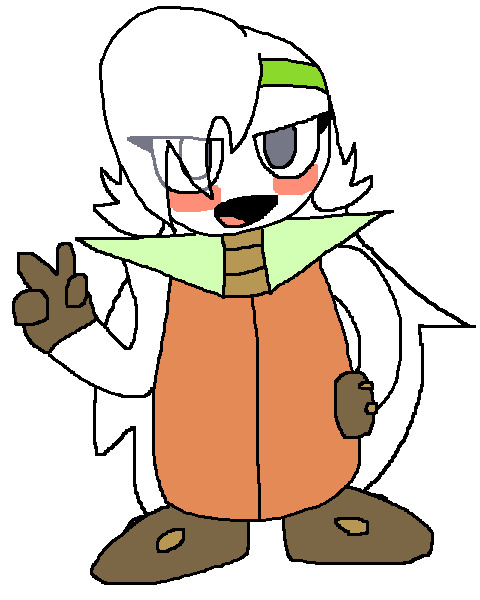
Thanks for reading, and sorry mobile users, if that glitch still exists.
#cant catch me gay thoughts#kirby#kirby right back at ya#hoshi no kaabii#krbay#it takes a lot of effort to write like this i hope u all like it. mwah#also i wrote this very early in the morning so if theres anything wrong with it uh. suck it up
53 notes
·
View notes
Text
Tiya Zhong: The Frederator Interview
vimeo
Tiya Zhong, known to the interweb as Addictiya, is an animator, illustrator, designer and doll artist still brushing off glitter from her graduation just a few weeks ago. Her final film as a student of Sheridan College’s Animation program, “Lost, Stolen, Dropped,” is an autobiography of her daily struggle. It is also among the most relatable, inspired and squishy 2 minutes of animation I’ve seen in a good long while. Enjoy the short above, then read on for Tiya’s journey from schoolgirl doodling in her textbooks to professional artist!

Did you always want to be an animator or artist?
I discovered my passion for drawing when I was 4 years old, and I have always loved doodling figures on my textbooks, reading comics, and watching animation. When I was little, I never thought about becoming an artist - I just thought it would be fun if I could draw forever. In high school, I wanted to be a comic artist, but I became fascinated with making characters come to life. Animation was even more vivid than comics, which is why I chose to major in it.
How did you decide to move from China to Canada to attend Sheridan?
I grew up in China, so at first I planned to attend a university in Beijing that features the best animation program in China. In an extra-curricular art school where I was studying to pass the university’s entrance exam, I met a substitute teacher who'd studied abroad. Talking with him made me realize how many opportunities and great artists are out there. That’s when I started to research animation schools in North America, and got to know Sheridan.
What did you like best about studying at Sheridan?
I learned a lot at Sheridan. The school has great, experienced teachers. But I learned the most from my peers, who are all amazing artists. Being in that group gave me no choice but to improve. What I enjoyed most is how free the environment is, compared to the one I’d been in. I also had a lot more resources at my disposal. Being at Sheridan really helped me discover my own art style.

Did you work any jobs during your time in college?
Since high school, I have always worked on stuff for conventions: things like zines, charms, and commissions. During college I actively kept my eyes on the industry and started to take freelance jobs. I’ve done character illustrations for games, art for a published illustration tutorial, design work, and more commissions, mostly with Chinese companies. I think it’s really important for artists to have at least some experience working with partners or employers before finishing school.
What are your favorite techniques, considering you've worked in both 2d and stop-motion? And those are just the two I know for sure!
Yes, I’ve done a little bit of 3D for assignments, but so far I’ve only worked in 2D and stop motion. I love both techniques equally! They are two different forms of art and each has stunning aspects. I love how free 2D can be, and how much you can play with crazy distortions, squash and stretch. I also love the process of crafting puppets and sets and being able to hold them in my hand.
What inspires you and your work the most?
Japanese anime definitely influences my work. They are my childhood and what made me keep the pencil in my hand! In the process of creating, I also look for references in many forms: live action movies, fashion, short films, photography. Anything related to art.
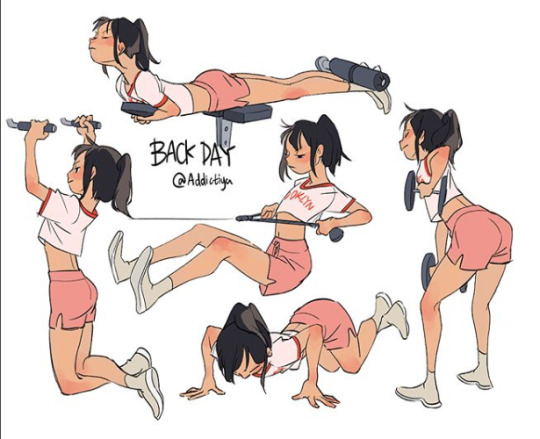
Is there anything that comes up in your work over and over?
I built my interest in life drawing while studying at Sheridan. Now, emphasizing the beauty and curls of human bodies has become a core part of my drawings.
How was the experience of creating "Quarters" in a team of 9 animators?
Creating “Quarters” with 8 other amazing artists was a really great experience! It was our first try, but there were no conflicts and everything went smoothly. Everyone pitched an idea for the film and we voted for the ‘four neighbors’ idea, which became “Quarters”. I worked on layout designs, prop and sets fabrication, shooting area setups, animation, and some post-production color corrections. We spread the work pretty much equally to everyone, so that we could all gain experience in every stage of creating a stop motion film.
vimeo
What inspired you to create "Lost, Stolen, Dropped"?
I had two other ideas for my final film before “Lost, Stolen, Dropped,” but they didn’t feel authentic to me. Personally, I prefer telling stories on subjects that I’m knowledgeable about, or have experienced myself. So one month into my 4th year, I gave up my first idea and all the storyboards I’d done for it. I thought, “What subject am I really familiar with? Is there anything that I know better than anyone else?” At the same time, I lost my brand new Cintiq pro pen. Not long before then I had lost my wallet. Aaaand my portable hard drive. My roommate commented that losing things is my everyday life. That’s what inspired me - I am really good at losing things! So I decided to make a film about that.
Love it. Do you often pull from your own life in your stories?
Actually, I can trace it back all the way to primary school! I used to draw comics as my diaries. With four panels comics, I’d record anything that happened in my life that I found fun. By the end of grade 7, I had a whole sketchbook of my personal life. I only showed it to my closest friends.
What were the biggest changes you made to "Lost, Stolen, Dropped" while working on the film? What were the biggest challenges?
I made a big change in the story. At the end of the first version, I made lots of copies of the main character, which came from all the different scenarios or timelines. They all appeared in her messy room, staring at her and guiding her to find her phone. That ending had a very dark and absurd feeling to it. The problem was, in order to explain that story and deliver the right feeling, the film would need to be a lot longer. And so, too much work for me. In the end, I changed lots of things and compressed the storyboard so I could finish it.

What do you plan to do now that you've graduated? Sorry to ask that question, I know it's the worst for new grads, haha.
Haha, I was so lost on this before, but now I kind of have a blueprint! The very first thing I want to do is find a job that I like, start saving, and get my PR (permanent residency) here in Canada, which is very realistic. I'll use my savings to go to grad school or take online classes: anything to improve my skills and broaden my perspective. Eventually, I want to work on personal projects without having to worry about financial issues.
Do you have a favorite cartoon, film, or artist?
Different films have been my favorite at different times in my life... I just love work that has great stories or strong emotions. I can’t really pick one film as my favorite, but Masaaki Yuasa is definitely one of my favorite directors! What I admire most about his films is how the abstract parts serve the expressive storytelling, and the drawings are always loose. That’s what I need to learn!
What's your biggest dream?
My biggest dream used to be becoming a zoologist! That was when I was 8. Now, my dream is to connect with great artists and studios over the world. To learn from them, work on fun projects, live a happy, healthy life, and occasionally go on vacations so that I can work on my other hobbies!
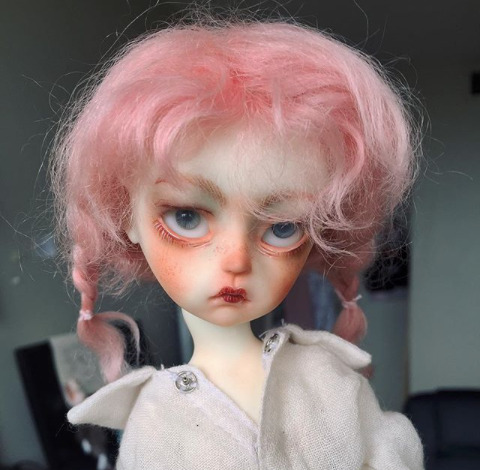
What are your hobbies outside of animation?
I’m interested in a wide range of things! Biking, gym exercise, photography, choreography, sculpting, sewing, leathercraft. But my greatest interest, outside of animation, is dolls and puppets! I love all kinds of dolls and toys. Different doll artists always make dolls with different characteristics, and that self-expression element is what appeals to me. I want to be able to create my own porcelain or resin doll one day. I am working hard toward that goal! ❀
Follow Addictiya on Instagram
Thank you for the interview Tiya! Love your work and am so looking forward to seeing what you do next. Enjoy home and your summer vacation pre-Adulting, you’ve earned the heck out of it!
- Cooper ❀
#The Frederator Interview#Canadian animation#frederator#Addictiya#Chinese artist#interview#artist#artists on tumblr#artistsoninstagram#doll#doll maker#short film#Lost Stolen Dropped#Sheridan#animation#animator#independent artist#2d animation#stop motion#cute art#art#cartoon#frederator studios
86 notes
·
View notes
Text
Saekano the Movie: Finale – Where Scenario Ends and Reality Begins

It’s been three years since Saekano Flat, and to be honest I haven’t kept up with news about a continuation of the story. All I know is I wanted to see it end happily with Tomoya and Megumi as a couple, and however it did that was fine. So imagine my surprise and delight upon learning a full-length movie would wrap everything up!
We pick up where Flat left off: Eriri and Utaha working on Fields Chronicle with Kosaka Akane at Mazuru; while Tomoya, Megumi, Michiru and Izumi work on Blessing Software’s next game: How to Raise a Boring Girlfriend. At an after-party for Icy Tail’s first solo performance, the two Blessing Defectors show up to support their friends, but their boss Kosaka inserts herself into the festivities to berate their work and force them to redo it.
Tomoya and Megumi aren’t really a couple yet, but they might as well be. Not coincidentally, Tomoya is in a slump with regards to writing the scene in which the protagonist confesses to the main heroine. He seeks Utaha for help, but runs into Kosaka first. Kosaka laughs at his story at first, but encourages him to embrace his inner deluded otaku and “masturbate more”—literarily speaking, of course…

Around midnight before their senior year begins, Tomoya runs by his Kosaka-inspired rewrites to Megumi. The two aren’t just on the phone for hours anymore, but Skype, face to face. It’s always been so lovely to watch these two simply working together like this while also dropping hints about how they feel about one another.
While Tomoya is determined to keep a crucial scene despite Megumi’s misgivings, he obviously wants her take on the main heroine, because she’s his main heroine. No big hug or crying fit is necessary, an ordinary event is sufficient to raising her flag. Before falling asleep to his typing, well past 3 AM, Megumi and Tomoya decide that because the game’s couple will be on first-name basis from this point on, they should do the same thing.
The next day at school, Izumi is about to greet Tomoya and Megumi, but sees how close they are and doesn’t interrupt (Eriri does though, not reading the room at all). The two then decide to act out a scene at the train station where they hold hands, and by God, the way those hands are animated—so subtle and gentle and loving.

Tomoya plans another “scouting” trip to Ikebukuro for them to “gather material”, on a day he knows to be Megumi’s birthday. When she asks if that’s all they’ll be doing, he initially puts the onus on her to say what she wants, then asks her if it’s okay if it’s about more than that, she says it is; that any reason will do. Then she notes that she’s not responsible for “what might happen”, before abruptly hanging up.
Their mutual realization they were about to go on a date for her birthday, not as mere colleagues working on a game, but as a couple taking the next step, is priceless to behold. I got so caught up in the buildup of anticipation and excitement to that magical day, I forgot how much movie was left. The day arrives, Megumi is at the meeting spot in the same outfit that first inspired Tomoya, only for him to call and tell her he can’t make it.
It was like a door in my chest opened up and my heart just fell on to the floor with a gruesome splat. Thankfully, he didn’t stand her up because he chickened out, but due to circumstances outside his control. Kosaka Akane had a stroke, and since she wasn’t carrying any ID, Tomoya’s card was the closest thing to an emergency contact.

This development angered me at first because it’s precisely the kind of dramatic twist he was trying to avoid for the Main Heroine route. Due to the stroke, Kosaka can’t currently use her right hand. Utaha tries to get Tomoya not to worry about them by saying her and Eriri’s work is mostly done, but Eriri doesn’t pick up on what Utaha is trying to do, and tells Tomoya the truth: they have no idea what this means for Fields Chronicle.
With Kosaka’s old friend Iori and Utaha’s manager stepping up to fill in while she recuperates, Tomoya initially volunteers to take over Iori’s promoting and negotiating roles for Blessing, but Megumi takes that on instead, insisting he need to have his undivided attention on the scenario. Megumi accepted Tomoya’s explanation and apology, but being stood up on your birthday by the guy you love is hard blow that’s left her weary.
Turns out she has good reason to be. Iori reports back to Tomoya with some dire news: even before Kosaka’s stroke, Fields Chronicle was over a month behind schedule. Kosaka prioritized the rapid artistic growth over finishing the game on time. Now the company is prepared to make deep cuts to both story and characters in order to get something to market without further delay.

This would obviously be an intolerable compromise for Utaha and Eriri, but they both know they can’t be the ones to try to argue their case to the company. They need someone who can go to the plate and negotiate, plead, and even get on his knees and passionately beg when logical arguments fail. And there’s just one person like that who knows and believes in their work. So they make the call.
Tomoya and Megumi meet up and sit on the same bench where they tenderly held hands and blushed, only for Megumi to deduce he’s going to Osaka to help Utaha and Eriri with their game. Tomoya cites how this is Utaha and Eriri’s best and possibly only chance at achieving true greatness and living up to their potential, and he can’t stand by and let their dreams be crushed.
But Megumi points out that he’s putting those dreams and that game ahead of their dreams and their game. Unable to hold back tears, she tells Tomoya that she can’t be his main heroine anymore, and boards the next train. But Tomoyo presses on for Osaka, and eventually makes some real progress, extending their deadline and sacrificing two characters so they don’t have to eliminate five. He sends Megumi texts, but she doesn’t reply. Why should she?

With their writer and leader gone, Blessing is on hold as far as Megumi is concerned. She’s also so rightfully angry at Tomoya her heart just isn’t in it…but Michiru and Izumi eventually get her to take up the mantle of their new leader, doing what they can do in Tomoya’s stead.
Indeed, Michiru and Izumi become a lot more assertive in telling Megumi they know she and Tomoya have been dating and are now fighting. Megumi rejects their idle gossip, but something fishy is going on: Izumi is drawing Megumi during her anguish, while Iori is typing on the other end of Izumi’s Bluetooth.
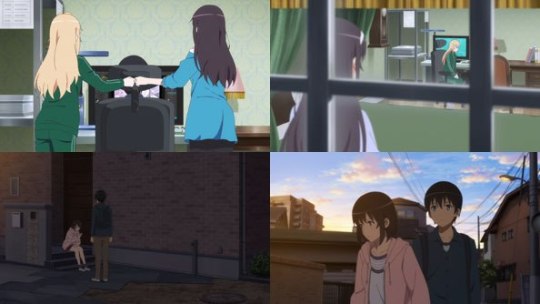
Utaha and Eriri end up completing their work, but rather than celebrate, Tomoya heads home at once. After he leaves, the girls remember what they agreed on before asking Tomoya to help: that in return, they’d help him finish his game and help him make up with Megumi. This meant letting go of Tomoya as a potential romantic partner for good and letting Megumi win.
While Tomoya was in Osaka, every minute he wasn’t helping Utaha and Eriri with their game, he was still writing the scenario for his, while at the same time penning a lengthy letter attempting to describe his feelings for Megumi. When he returns home she’s waiting on his stoop, his letter in her inbox, which she describes as “disgusting”.
Megumi wants to be mad at Tomoya and doesn’t want to forgive him for what he did, but she also “doesn’t care” about any of that, because what’s most important is that she loves him. That’s why she brushes his hand away once, but not twice. The second time she keeps their hands locked, and then Tomoya beats her to it by confessing first.

Tomoya loves his 2D Main Heroine, but he loves the 3D Katou Megumi most. When she asks why, he says it isn’t out of admiration, obsession, or obligation. He’s perfectly frank in telling her she seemed more in his league as a partner than the dazzling, infinitely more talented Utaha or Eriri. Only with Megumi can he feel and act like himself and tell her what he’s really feeling.
One would think Megumi should be insulted by Tomoya’s rationale for choosing her. But in a continuation of her monologue to Michiru and Izumi, she confesses that she wants Tomoya to be hers and no one else’s. Because there’s no drama, like the other girls. Because they’re so wonderfully “normal” together. So Tomoya’s explanation passes muster.
Soon the two are locked in a hug, and when Megumi’s eyes are closed, after some hesitation Tomoya kisses her. She wasn’t quite ready, so she kisses him in turn. Finally, the two count down to have a perfectly timed third kiss. This was one of the best anime first kiss(es) scenes I’ve ever seen.
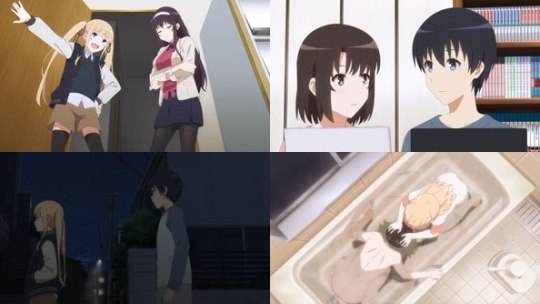
Kosaka recovers, thanking Tomoya for his help while she was out of commission and offering to read his work (and skewer it viciously) anytime. Tomoya incorporates the details of his and Megumi’s real-life mutual confession into the game and Izumi creates more art for it.
Eriri and Utaha arrive to help out and immediately insert their strong personalities into the project with abandon. When Eriri takes a break, Tomoya follows her out to apologize for…well, everything, but most importantly for what he doesn’t explicitly state: not choosing her. She takes it as well as she could be expected to, asking before heading back whether Tomoya loved her ten years ago.
Eriri then joins Megumi for a bath and briefly waterboards her in frustration, not just that she lost, but that Megumi loved Tomoya so much they made up and started dating before Eriri or Utaha could arrive to help them. After the whole gang pulls a near-all-nighter to complete the game, the two girls tuck everyone in and head out, vowing to keep running together so he can’t catch up, knowing he’ll keep chasing them regardless.

The day of Comiket arrives, and Tomoya and Megumi head to the venue hand in hand like the couple they are. Tomoya wonders if 2,000 copies was too many to print, but they sell every one, validating their hard work as well as the inspiration Megumi provided.
Tomoya and Megumi graduate from high school and return to the spot where they first met, with Megumi in her now-iconic red sweater and white cap and skirt. Roll credits!

After the credits we jump forward what looks like a couple if not a few years. Megumi is suggesting to an overworked Tomoya that they break up, since he’s stuck at his sales job so much they hardly ever see each other, and in any case suspects he still carries a flame for a certain someone. Tomoya has given up on his dreams, and while Iori hasn’t, he’s now a penniless delusional vagrant.
Just when I thought we’d reached Saekano’s “Bad Ending”, Tomoya suddenly encounters a short-haired Utaha by the waterfront, the music rises, and she’s about to start singing when Eriri snaps us out of it; this was just the visualization of a spec script for a new game half-jokingly written by Utaha. The two are in a meeting with Iori and a Tomoya who is very much living the dream of being. Glorious fake-out!
He is the president and Megumi the vice president of Blessing, now an established and successful game company. Utaha’s script hit Tomoya hard, though, so he hugs Megumi when he sees her next, and asks her to reassure him she’s not going anywhere. Of course, she does, but when Tomoya leans in to kiss, she wants to save it for when they get home.

Unfortunately, they are unable to bone when they get home, because their apartment is suddenly overrun by the talent: not just Michiru and Izumi, but Utaha and Eriri have also shown up for their first sleepover meeting in years. Tomoya and Megumi take the intrusion in stride, but Megumi makes sure to steal a kiss, in the process revealing he put a ring on it. Good lad! The six friends gather around the table for a toast to another hit from Blessing, and the curtain finally falls for good on the movie, and on Saekano.
Until I sunk my teeth into this movie, I didn’t realize how much I missed the show’s great mix of comedy, romance, drama, artistry and extremely effective fanservice. I could hardly have asked for a better, more satisfying ending than the one we got.

By: sesameacrylic
0 notes
Text
3D Printing Mega-Post (with links!)
Being a member of the maker community means I am surrounded by people who are totally in love with 3D printing. There’s no other group with whom I can have a 30 minute discussion about bed adhesion, lol. While the cosplay community is also generally supportive of the technique, every now and then I will come across somebody who thinks it is akin to cheating. Most recently it happened on a blog I really enjoy. When I read posts like that, I can only shake my head and assume that person must not really understand all the work that goes into 3D printing. Even in the best case scenario where you find a ready-to-print model and own a printer large enough to accommodate it, there is still tons of work that goes into taking a raw print from... well, a raw state to something beautiful. Hence I have decided to type up an overview of 3D printing; what it is, how it works, and all the steps it takes to create a cosplay prop. This is not a detailed tutorial; rather, it’s a high level scope of all the steps. Without further ado, here’s 3D Printing 101!
*12/20/17: Updated with new information on the latest printing technology plus even MORE links!
How does 3D printing work?
3D printing is an additive manufacturing process used to create three-dimensional objects; think of it as the opposite of sculpting where you start with a block of material and cut parts away (subtractive manufacturing). There are actually many types of 3D printing technology, but the most common for hobbyists by far is Fused Deposition Modeling—or FDM for short. In plain English, FDM means the printer head is essentially a hot glue gun that “draws” the cross-section of a model, building it up one thin layer at a time. After tens or hundreds of layers, ta-dah! You have a 3D object! You can check out this link for more info on other types of 3D printing.
The workflow for printing looks like this: find/make a 3D model, optimize that model for printing, convert it to G-code with a slicer, and send it to the printer. Once printing is complete, you need to assemble any separate parts, fill major gaps, fill/prime/sand the surface, and then paint. If any of those terms are confusing, don’t worry! I will explain them all.
Finding, Modifying, or Making a Model
Sourcing models is one of the topics where I see, “Cheater!” start to sneak in. There is a misconception that you can find just about any model you want, download, and hit print. This can be true depending on what you’re trying to build; popular cosplays like Iron Man, Halo, and Star Wars do have a plethora of models available for free, and many are already optimized for printing. Once you get outside well known characters, however, it gets much more challenging. If someone has 3D printed components in their cosplay, it’s never safe to assume the person just downloaded them.
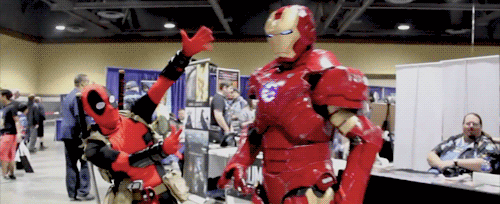
Downloading Models
It’s always worth hunting around for the files you need even if the character isn’t well known. Even if you want to build everything from scratch, it is nice to see how someone else tackled the same challenge. There are a couple websites I like for searching for printable models:
Thingiverse: Run by Makerbot, Thingiverse is a huge collection of models designed specifically for 3D printing and all of them are free! This is where I always start my search for 3D printing files. Most come with some degree of instruction and suggested optimal print settings.
GrabCAD: I don’t use this site as frequently for costuming since the focus is engineering, but it’s very possible to find some cosplay goodies there. Other than scaling, most models should be ready to print.
SketchFab: While this was originally a place to share 3D models, some users also make theirs available. If you need a file for printing, be sure to search through the Downloadable section. (and even if you can't download the file, a 3D reference beats 2D refs any day!)
When selecting a model, try to find something that specifies it was made for 3D printing. Otherwise, you may need to do some manual cleanup and that can be challenging. Just FYI, game models are never ready to be printed but if you want to start with them, Source Film Maker has hundreds to select from. it’s also worth Googling to see if anyone has offered ripped models for free, but be aware that these should NOT be used for profit. Steriolythography (or .STL for short) and Wavefront (.OBJ) are the two most common file types, but get an STL if you can. OBJs will often come with texture files (.mtl), but those are not needed for printing. Aim for highest resolution you can find unless you want the low-poly look. Trust me, you don’t want to be filling in faceted planes with heaps of Bondo later.
There are a few products and processes that allow for multi color printing, but for the most part FDM machines are limited to one or two colors. If you are bound and determined to have multiple hues, you can check out Prusa’s new Multi-material upgrade, the new Da Vinci Color, or the Palatte Filament Splicer. I suspect that multi color printing is going to be one of the next major features to hit hobby printers, but for the time being most methods are either rudimentary or really expensive. It can also be fun to print with multiple materials such as combining rigid and flexible pieces, but that is best reserved for a dual extruding printer. When it comes to cosplay, I would either suggest printing in the object’s final color or preparing to paint. Even if you choose to paint, try and pick a filament color that will make sense if it is revealed through wear and tear.
Modifying Models
If something wasn’t specifically made for FDM, how do you know if it’s printable? Most commercial 3D modeling or CAD software have tools to check and correct issues with models—sometimes automatically. Unfortunately the easy-to-use, open source options in this area are a little barren but there are still ways to do it. Here are some free options for both checking and repairing mesh issues:
MakePrintable is an online paid service, but it will let you repair a set number of models per month for free. In my experience, this is best for basic issues but it couldn’t get any easier.
Microsoft STL Repair: Similar to MakePrintable, but unlimited and free. The downside is that you have zero control in the process, and files need to be opened with Microsoft’s free 3D Builder (from there you can export as an STL).
MeshMixer: An Autodesk product that has a number of capabilities for manipulating meshes. It’s more complex than MakePrintable and Microsoft 3D printing, but you have way more options.
Meshlab: Ah, Meshlab. This program has been around for a long time, and in many ways it is incredibly capable. Unfortunately, it’s also somewhat unstable and has bad documentation, so tutorials are hard to find.
Blender: A popular open source 3D modeling program, Blender also has a 3D printing add-on with some mesh analysis tools. This is the most robust option I have tried, but Blender has a steep learning curve and it can be intimidating for newbies.
Making Models
There is a good chance that you won’t be able to find ready-to-print files, so you might need to heavily mod or even make your own from scratch. Unfortunately, you will need to jump into 3D modeling software to make this happen. There are two major categories of software types: engineering (computer assisted drafting, or CAD for short) and artistic. In a nutshell, CAD is usually meant for objects (cars, wrenches, buildings, etc) and offers tight control over dimensions, surfaces, and shapes. Artistic software can be used for just about anything from trees to characters to spaceships, but it can be more challenging to make precise mechanical objects. I use both depending on what I need to create. There are actually a ton of free 3D modeling tools, so I will list the ones I have experience with and can recommend.
TinkerCAD: This is probably one of the most popular free CAD programs, and for good reason. It’s browser-based and very intuitive to use, thus it has become popular in schools. The entire thing revolves around building objects out of primitives, so if you need something complex it might take a little creativity to get there. TinkerCAD also has its own library of downloadable objects and it can export items for 3D printing (or even send them to a printing service!).
Google Sketchup: Available in both free and paid versions, SketchUp is a lot more complex than TinkerCAD but still very approachable. For some reason, it would drive my professors nuts when anyone used this software for homework. Be sure to check out the hefty list of extensions as they can significantly increase the program’s capabilities.
Autodesk Fusion 360: I will admit that I haven’t used this one very much, but it has been getting very popular very quickly. Fusion 360 is a fully-featured, professional CAD program meant for industry use, but it is available for free to students, startups, and hobbyists. If you want to grab the bull by the horns and work with maximum potential, get this software. It can be intimidating for someone who has never set foot in CAD before, but it is one of the most approachable fully featured CAD suites I have ever seen.
Sculptris: And now for something completely different! Sculptris is the baby brother of Z-brush, an industry standard software for digital sculpting. It’s actually very capable, and if you need to model something organic or CAD just isn’t making sense, give Sculptris a whirl.
MeshMixer: MeshMixer’s site calls itself, “a Swiss Army Knife for 3D meshes,” and that’s pretty accurate. It has some CAD capabilities mixed in with artistic tools and a few unique things to boot. It’s reasonably easy to use, although there could be more tutorial support in my opinion.
Blender: Ah, good ole’ Blender. Completely free now and forever (unlike many Autodesk programs), it’s the most capable and robust open source software I have ever used. Blender is definitely on the artistic side although it has add-ons that make CAD a little less painful. The major downside is the interface; simply put, Blender is incredibly unintuitive. Thankfully, Youtube has tons of high quality tutorials to get you started.
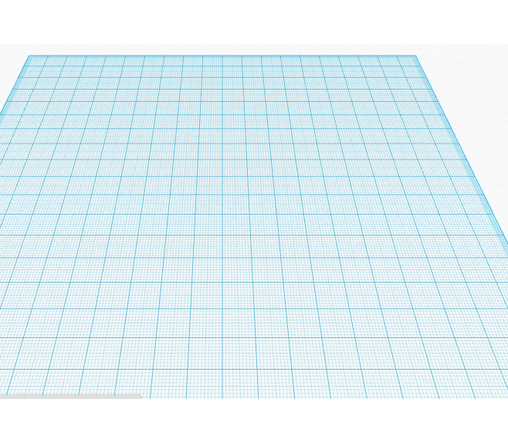
Slicing
Once you finally have a printable model in your possession, it’s time to send it to a 3D printer. If you are using a 3D printing service, congratulations! You can send them your model and call it a day. The rest of us will need to use a Slicer. Remember how the printer moves a hot glue gun around to draw a shape? Well, the computer needs to tell the printer head where to move, how fast to move there, and when to start and stop drawing. It uses a language called G-code to do this. A slicer’s job is to convert a 3D model into G-code so the printer knows what to do.
I use a free slicer called Cura from Ultimaker, but Slic3r and Repetier Host are popular options too (although more advanced). If you want ultimate control, cutting edge features, and don’t mind paying for it, Simplify 3D is considered the best slicer on the market. Cura is my slicer of choice due to its friendly interface. In the photo above, you can see how it has made layers out of a model (hence the name “slicer”).
The first thing to do will be properly scaling your print. Cura assumes your units are millimeters by default, so you may need to convert to your original modeling unit (inches, my my case). Unless you are printing a small prop or have a very large printer, your parts will probably be too big to fit on the print bed. If this is the case, return to your modeling software and split into smaller pieces.
When it comes to 3d printers, you get what you pay for. The more expensive models ($1500+) offer the closest thing you can get to plug-and-play experience, but even they will have failed prints, clogged extruders, and other common issues every now and then. The rest will need some degree of hand-holding. It took me about a week to get my $200 Monoprice Select Mini printing to the best of its ability, and that involved a lot of fiddling in Cura and 18 test prints. Spend some time optimizing your software for the fastest, highest quality prints; you’ll be grateful you did once you get to the sanding phase.
Update: After 10 months of regular, reliable performance, the board on my Monoprice Mini has died. At $160, I definitely got my money’s worth and other users have had theirs much longer. I am upgrading to a Prusa i3 MK3 kit, but I would still recommend the Select Mini v2 as a good gateway machine.
Printing
With your slicer ready to export G-Code, now is the time to set up your printer! A 3D printer’s “ink” is spools of plastic string called filament. There is a variety of plastics to choose from, but Polylactic Acid (PLA) and Acrylonitrile Butadiene Styrene (ABS) are the most common. PLA is cheap, readily available in many colors, and is made from plant starch. For most people, it’s the go-to choice but it is not the strongest material. ABS can provide better structural integrity, but it’s a little more finicky to print and the fumes are noxious and require ventilation. This link has a good summary on various types of filament on the market.
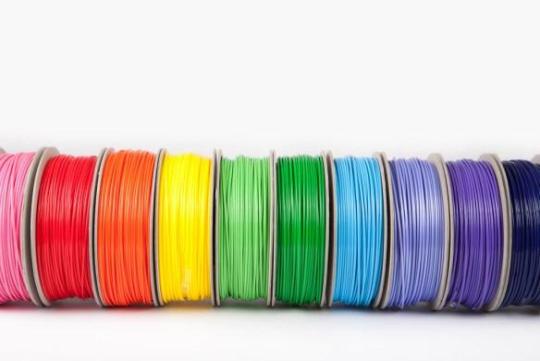
If you search Amazon or Google for 3D printing filament, you will get approximately 82376483456978938 results. Be sure that you are searching for the proper diameter filament; most printers are 1.75mm, but some are 2.85-3.0mm. Reliable brands of PLA that I have worked with are Hatchbox, Matterhackers, ProtoPasta, and ColorFabb. Be wary of no-name brands off places like Ebay or Amazon; not all filaments are created equally and I have definitely wasted money trying to be thrifty on Amazon.
With your filament loaded in the printer, it can be a good idea to extrude some and make sure everything is working properly. Next, verify you set the proper export settings in the slicing software. Different plastics need different speeds and temperatures, and often the packaging will give you a good suggestion. When all is ready, slice the model and send the G-code to your printer!
I always stick around to watch the first few layers of my print because most mistakes happen at that point. Bed adhesion in particular can be troublesome. My solution of choice for PLA is a layer of blue painter’s tape with a light misting of hair spray. Others have used glue sticks, but that didn’t work well for me. If you notice any problems, pause immediately and try to fix the issue. A small clog can turn into a major problem if plastic goops all over your extruder.
When the print is done, it can be tempting to pull the model off the bed but have a little patience! The plastic can warp while it is still warm, plus your printer will still be hot. Let it cool down slightly, then pop it off the bed.
Surfacing
Now comes the tedious part! First of all, remove any supports (or if you have a dual extruding printer, dissolve support filament) with pliers. Depending on the support type, a box knife or X-acto can be handy. I have also heard that deburring tools are handy for this. Next, assemble separate parts with glue. CA or epoxy are good choices, or you can get fancy with friction welding. If you printed with ABS, acetone can help glue pieces together and even smooth your model.
Next you will need to fill any major gaps such as those found along seams or where errors may have occurred in the print. Bondo Glazing and Spot Putty is a popular option for large holes and epoxy can be used as well. You can also use wood filler although I would reserve this for parts that will not be subject to a lot of handing or strain as it can be a little brittle.
Now you have to do something about all those layers.
Your options are sanding, smoothing, or a combination of the two. In the past I have wet sanded the plastic starting from 120, 220, and 400 grit wetdry sand paper. The “wet dry” part is important because PLA will heat quickly from friction and then you have to wait for it to cool again. If I wanted the plastic to show, then I would take it to 1000 grit or even a bit higher. 220 is the minimum for a matte appearance and slightly rough feel whereas 1000 starts to approach injection molded plastic. Bear in mind that dark filaments will show scratches and need sanding at finer grits to look clean. If you intend to paint, 400 grit paper is high enough. Then you will need to spray your model with primer. Allow to thoroughly dry (no longer cold to the touch) and sand with 600 or 800 grit paper. Reapply primer and continue sanding until you are satisfied with the surface. I have found 3 or 4 coats to be sufficient. Paint will hide very few defects, so you can’t take shortcuts with this step.
You can circumvent some obnoxious sanding by filling the layers first. Automotive filler primer works wonderfully although the fumes are terrible and it will need be to used in a well-ventilated area. Filler primer is much thicker than normal primer and with enough coats, it will fill in all those grooves. I found that 3-4 light coats built up a good base to start sanding, and then another 3 coats with sanding between each application gave an excellent finish. This might sound tedious (and it is, to be honest) but the primer sands much easier than PLA. I was satisfied with the finish 220 grit sandpaper provided.
I have heard that CA glue is also good for filling grooves, and Smooth-On makes a self-leveling product called XTC-3D that you paint over your model. I haven’t tried either of these, but they get good feedback from others. Finally, if you have printed in ABS you can try vapor smoothing your part; just be careful playing with acetone, and don’t do it too long or you’ll melt your piece.
Now with all that said, my experience with finishing 3D prints was with the intention of creating a production-quality model (aka something that looked like you bought brand new it from the store). Every print needed to be practically flawless when viewed at close range. For cosplay, this is unnecessary. Nobody is going to hyper-analyse your work from inches away; rather, you can rely on the 10 foot rule. Also, weathering will hide many defects
Focus your efforts on pieces that will show the most. For Soldier 76, this means I will be spending many hours making his mask smooth and pristine, but I’m not even going to paint the brackets on his boots.
Painting
Now you are on to the last step! Unless you wish to control texture through brush strokes, I always recommend spray painting or airbrushing. Rattle cans are available in a myriad of colors these days, but if you have an airbrush they are handy for detailed work. I had a professor who wouldn’t let a can of Rustoleum in his classroom and demanded we use Krylon, so I guess you should also use Krylon? The artists I know who use spray paint swear by the Montana brand, and they have a huge range of colors to select from.
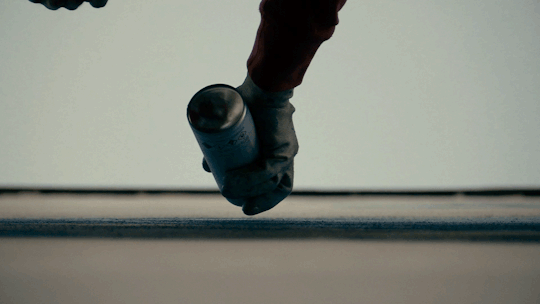
Anyway, all your spray painting should be done outside or in an area with plenty of ventilation. I always wear a dust mask--not because I’m worried about paint fumes (dust masks don’t stop fumes anyway)--but because I don’t want to breath in teeny paint particles. Even if paint is non-toxic, it doesn’t belong in your lungs. I also like to tape down a huge backdrop so I don’t get any over-spray surprises. Your coats of paint should be incredibly light, almost like dusting the model with pigment. It will take many coats, but the slow buildup guarantees even application. I promise the effort is worth it, plus thin coats of paint dry quickly anyway.
Sealing
Last step! I have always used rattle can clear coats to seal my models. This step should not be skipped because your paint job can be marred very easily, but the sealer will help protect it. Always, always, always use the same brand of sealant as your paint or test on scraps first. I cannot reiterate this enough; not all products will get along together, and nothing ruins your week (or month) quite like destroying a detailed paint job. If your model will be going through a lot of wear and tear, you may consider coating it in clear resin for durability.
Conclusion
So as you can see, there is a LOT more work to 3D printing besides downloading and hitting print. I didn’t even go into detail and the post is huge. Any of these topics will have more information if you search on Youtube or Google, plus my Ask is always open. I hope this helps somebody!
69 notes
·
View notes
Text
Summative assessment
One of the Themes that I looked at and enjoyed on a Monday lecturer was ‘the labyrinth and the Maze’. In the text Tim Ingold talks about walking, imagining and the education of attention. After this Monday lecturer my research consisted in looking at a lot of labyrinths and mazes. What is the difference between a labyrinth and a maze? A labyrinth has a single path which winds through it where as a maze can have many paths. So mostly you can get labyrinths in mazes or they can be separate. The design of the labyrinth simultaneously represents a puzzle and a solution, a journey and an arrival.
The word labyrinth comes from a Greek mythology. It was designed by the legendary artificer Daedalus for king Minos of Crete at Knosses. It was to hold a monster who was born from the kings wife and the love with a bull. So this is how the story went. So King Minos ordered the labyrinth to be built as a prison for minotauros. Minos' wife Pasiphae had made love with a bull and the king thought that it should be hidden from the world especially as it fed on human flesh.
A labyrinth is an ancient symbol that relates to wholeness. It combines the imagery of the circle and the spiral into a meandering but purposeful path. It represents a journey to our own centre and back again out into the world. Labyrinth have long been used as meditation and prayer tools.
In the text, ‘The Labyrinth and the Maze', by Tim Ingold, goes on talking about that the streets are a Labyrinth. So when you go out on the streets or go in the city it’s explaining your ability to walk around and not knowing where to go. However it argues that the city is not a labyrinth when you consider yourself a business person. It goes on to explain that in your everyday life you get use to your surroundings and making that part of the regular routine on the way to work and it just becomes a place passing by rather than a place to wonder. I think I can argue the fact that I do think that a city or a street is like a labyrinth or a maze. My reason to this is that I believe that although some people walking around the city is normal in there every day life however, can at least one of those people say that they didn’t need to use Google maps to find there way, or signs to guide them out of the maze. Now imagine a world without signs and devices to help you out and what do you call your self in city walking around not know which way to go. Lost in the city. By architectural theory labyrinth has been linked to the archaic encounter between the nomadic and the city.
When talking about a city, we use the word labyrinth metaphorically hinting towards movement patterns. James Donald’s, ‘imagining the Modern City', shows the city and its architecture can be at once rational and irrational, observed and imagined, theoretical and empirical. show a different understanding of space, seeing it as something other and more than a field of mathematical calculation and political instrumentalism.
Some say that the labyrinth looks like a ‘natural’ pattern, reminding of the finger-print, or the interlacing intestines or the brain. I think I can relate to this as when you look at a labyrinth especially the circle ones, it does look like it and reminds us about the body of a human. It reminds us of these natural, biological forms due to the belief the labyrinth is culturally created. So this meaning that it is and artificial construction, made by humans for humans. “The idea of a labyrinth is a place in which we lose ourselves in order to find ourselves is intriguing,” said Anthony Bostrom. With this quote I believe in some level is true, but the problem that people have is if they are completely lost physically, they would mentally not be able to cope. So in some sense everyone needs a pull to their Direction I believe. ‘ To be inside and maze is to be a wildered or afraid, but it’s also to be inside a structure- lost but only up to a point.’ This quote strengthens my theory. Being exposed and not knowing it.
Robert Morris (born February 9th 1931 and died November 28th 2018) is an American artist and sculptor which designed the outdoor labyrinth as a 6-month long interactive illustration in the Donald Hall sculpture park at the nelson-Atkins Museum of art. Built on a base of concrete stone the 7-ft tall glass structure with more than 400 tons and took more than 80 crew workers to build on the site.
Why I liked this piece? The piece, glassed labyrinth, engaged with the public allowing them to experience the excitement as well as the overwhelming of bumping into the see through glass. What I find quite funny is probably the amusement this piece would of created, and making it fun. Roberts work consisted in hand making a sculpture which the public could go through. His work was made from glass which made me consider that most labyrinths or mazes have a wall you can't see through whereas his didn't. It made me think of the difference and come up with theories. Can you see through, do you know your Direction? Going back on the text I read on a walk on a Monday lecture, ‘the maze and labyrinth’, I remember him saying “education along the lines of the Labyrinth does not provide novices with stand points or positions, but continually pulls them from any positions they might adapt. I would of liked to experience going through the labyrinth and to understand more on why people would of bumped into the walls a lot? In some sense I can only relate to a piece like this by remembering going to a fair ground and going through a room full of mirrors. I have a hint that in some kind of way these two scenery are quite similar. What is quite different compared to this labyrinth to others is that most consistent shapes used in a labyrinth would be circles, squares or rectangles. So why did he choose a triangle? Triangulated and constructed of glass plate wall capped with bronze, speaks to the present in the language of modern architecture and design- streamlined, dynamic, transparent and elegant.
The transparent piece allows visitors to see each other and the landscape, while wandering around. The aim was to reach the centre and find the way out of the triangular form. This modern and unique stunning glazed piece was designed for people to experience, explore and enjoy. In his earlier work he explored space as an extension of the self. The viewers were forced to become aware of their sense of place, direction, memory, etc.
I also came across a work by Chris Skinner which is an graphics illustrator from Derbyshire. He has 14 years experience in design. He also works in several different companies making graphic design which meets the clients needs. He has worked with different range of sectors such as, broadcasting, motion graphics, print, etc. His main focus is illustration although, he has done work that consisted in 2D digital, 3D modelling, digital sculpting, motion graphics etc. Chris has his own distinctive style: it comprises a mixture of hand drawn elements and 3D modelling. The work I looked at presented the actual film from the Labyrinth and it included some of the characters from the goblin City. His piece was an print for the 1986, musical ‘labyrinth’. For inspiration, he used the original of the staircases- which was in the scene of the movie of Sarah’s bedroom wall- Relativity by M.C. Escher.
I like this piece because it consists the characters from the film which is one of my all time favourites. What I really find fascinating is that he also included some of the scenarios which are seen in the film. Right at the top of the image you have a sketch of the maze that Sarah the main character had to go though to get to the goblin city. On the right of the piece you can see another part where Ludo and Sarah had to go through the sewer part which there they met two new friends. I think that with this piece I can relate so much to it. It also tells the story of the labyrinth and where Sarah travelled and went by to get to the goblin city and get her little brother back, toby before the goblin king turned him into a goblin.
Escher (born June 17th 1898 and died March 27th 1972) was an Dutch graphic artist who made mathematical inspired wood cuts, lithography and mezzotints. His work ‘Relativity’ is a lithograph print which was printed in December 1953. It creates a visual image of a world where gravity ceased to exist. His drawings plays tricks on the audience eyes, fooling their mind to think that it never ends.
Escher’s work features mathematical objects and operations including impossible objects, etc. Even though he believed he didn’t have the mathematic ability, he still went on making a whole book full of work. In all his work that he did, they all consisted repetition of either the same object or piece. In his earlier work he drew from inspiration from nature, studying insects, landscapes, and plants.
His work creates an art movement of surrealism with a unique 3-dimensional style. Within the imagery of the lithograph is seen as an architectural structure. It has been said that Escher through his research, his did went on looking at the mathematic structure of things such as buildings, rather than the building on the outside. In his work ‘Relativity’, it reflects the different rules of gravity rather than the common form of gravity known in the real world. I find it quite fascinating to look at this piece as to that persons down, is someone’s down. It’s like being a child again and being on that climbing frame with different directions. The people in the piece do not seem to be concerned or affected by the gravity difference.
A book that I looked at which consisted his work, told me that his approach though all his pieces consisted the similar way he would do it as well the repetition.
The difference between Chris’ work and Escher’s work is that the people in Chris’ piece are given an identity as it reflects the film ‘labyrinth’ and Escher’s piece, the people are not given an Identity as they are all the same. They are not given a face as he does not want that to be the attention to his audience. His aim was more to do with repetition of the staircases and looking at the mathematics of the structure. The similarities of theses two pieces is that they both consist staircases and have no sense to gravity. They both also have the same styles. For example, they are both prints, only use black and white and no colour, and the use of the 3-dimensional style/structure. The use of just using black and white gives it a sense of the piece being old and an sophisticated design, it gives it importance in the world. Imagine if was in colour, would the audience it’s trying to attract change? ‘The three-dimensional world may be projected onto a two-dimensional plane to create the illusion of space', this quote made me think of these two works as in a way these two pieces do this I think.
Similarities and differences between these three pieces of work. We can say that with Chris’ and Escher’s pieces are very similar, where as with Robert’s work, its different from these two pieces. What I can say about all three pieces is that they do have that architectural structure feeling to all of them. Even though their formats were quite different in showing of there types of labyrinths, it help me understand what they really wanted to get out of their pieces. With Robert’s he wanted the audience to explore and enjoy his work by making it engaging for the audience. Escher’s and Chris’ were more about allowing the audience to engage though the sense of sight. The type of audience Robert’s piece attracts are very different compare to Escher’s and Chris’ piece. Reason being is that Robert’s work is presented in a park which everyone goes to, children, runners, adults, artists, etc.
With Robert’s work you can see through and it questions all because you can see through it and you see what you want to get to, you want to get there quicker and without the struggle. I think there’s so many pathways in the persons way and they forget about that. With other Labyrinths you can’t see through the walls which, I think it makes it even more easier for you to know which way you are going so for example if you are a student learning science and you want to be a science teacher, to get there you need to go through certain things such as GCSEs and all that. You know that there are different paths in front of you which you have to go forward as there’s no other way. Where as I think that with Robert’s work because you can see through, it makes it more difficult to know what path you are on at the moment as you can see the finish line. In my theory I think that if you see the finish line you rush like a sprinter wanting to win in a race and knowing this I think with what ever path they are on they just want to get through it quickly.
In my conclusion after looking at all theses in my research, I have questioned myself in my making and why I chose tunnels as an approach to my inspiration of the labyrinth? And why I have created them as a solid object (in clay)? Are tunnels labyrinths, and what are the differences between my work and the artwork I looked at? So, what if I took a walk though Colindale and I saw a tunnel and that’s why I chose to do a tunnel, in my sense the tunnel was part of my journey and labyrinth conclude in this. Looking back at Robert’s work he didn’t stick with a shape that connects with a labyrinth on what we know, we normally see shapes such as circles and squares, not triangles. Knowing this I used the same approach as him and looked at a labyrinth being different. For example, the sewers of London are not seen and are well known as a labyrinth. They are like the forgotten parts because they are not pleasant to be included however, they are labyrinths/mazes that are in this world working right under us as we speak. And come to think of it tunnels can be the labyrinth of your journey on an underground train. As an artist I can say where I am still with my work is still experimenting and developing my work in a context as a labyrinth. And in relation to what I have spoken about I can strongly say that I have a strong understanding of the meaning of a labyrinth.
Labyrinth are part of everyone life, you just got to look at things in a different way. I do believe that the city works as a labyrinth or reminds us of the pattern using architectural structure and having different directions which still can lead us to the same destination. I see the labyrinth as a movement of patterns or dance. It has been said that labyrinths have been used for humans entertainment in dance, moving left to right, up or down.
The pieces that I also looked at does present the labyrinth very well I believe. The reason why I think this is because work brings the overwhelming and the feeling of an labyrinth as well as consisting pathways like a labyrinth. So it refers to a labyrinth when you see the pieces too.
References/bibliography
https://www.theguardian.com/books/2018/jul/28/myth-monsters-and-the-maze-how-writers-fell-in-love-with-the-labyrinth
https://www.citylab.com/design/2014/07/why-every-city-needs-a-labyrinth/373965/
Henning Eichberg,IFO/Research institute of sport, gerlev, Denmark,2004,p1-9
https://www.ancient.eu/Labyrinth/
James Donald, imagining the modern city
http://australianhumanitiesreview.org/2000/06/01/review-imagining-the-modern-city-by-james-donald/
https://www.academia.edu/1330469/THIS_HERE_NOW
https://mymodernmet.com/robert-morris-glass-labyrinth/
https://books.google.co.uk/books?id=JHRnAPobeo0C&pg=PA35&lpg=PA35&dq=labyrinth+robert+morris+what+other+people+say+about+it&source=bl&ots=ofUYTfgmas&sig=ACfU3U2QJPAGAlbb_0pOpNEDEIsZf6mX4w&hl=en&sa=X&ved=2ahUKEwjTssvoyszoAhXjTRUIHXotAl0Q6AEwDnoECAYQAQ#v=onepage&q=labyrinth robert morris what other people say about it&f=false
https://www.debutart.com/artist/chris-skinner
April Cheetham, a ceiling of identity: anamorphosis as double vision in contemporary art practice, liverpool John Moores University, May 2012, p1-155
Tim Imgold, the maze and the labyrinth, p1-12
Georg Simmel, the metropolis and mental life, p1-9
Massey, A place called home, place and identity, London (1992), p1-17
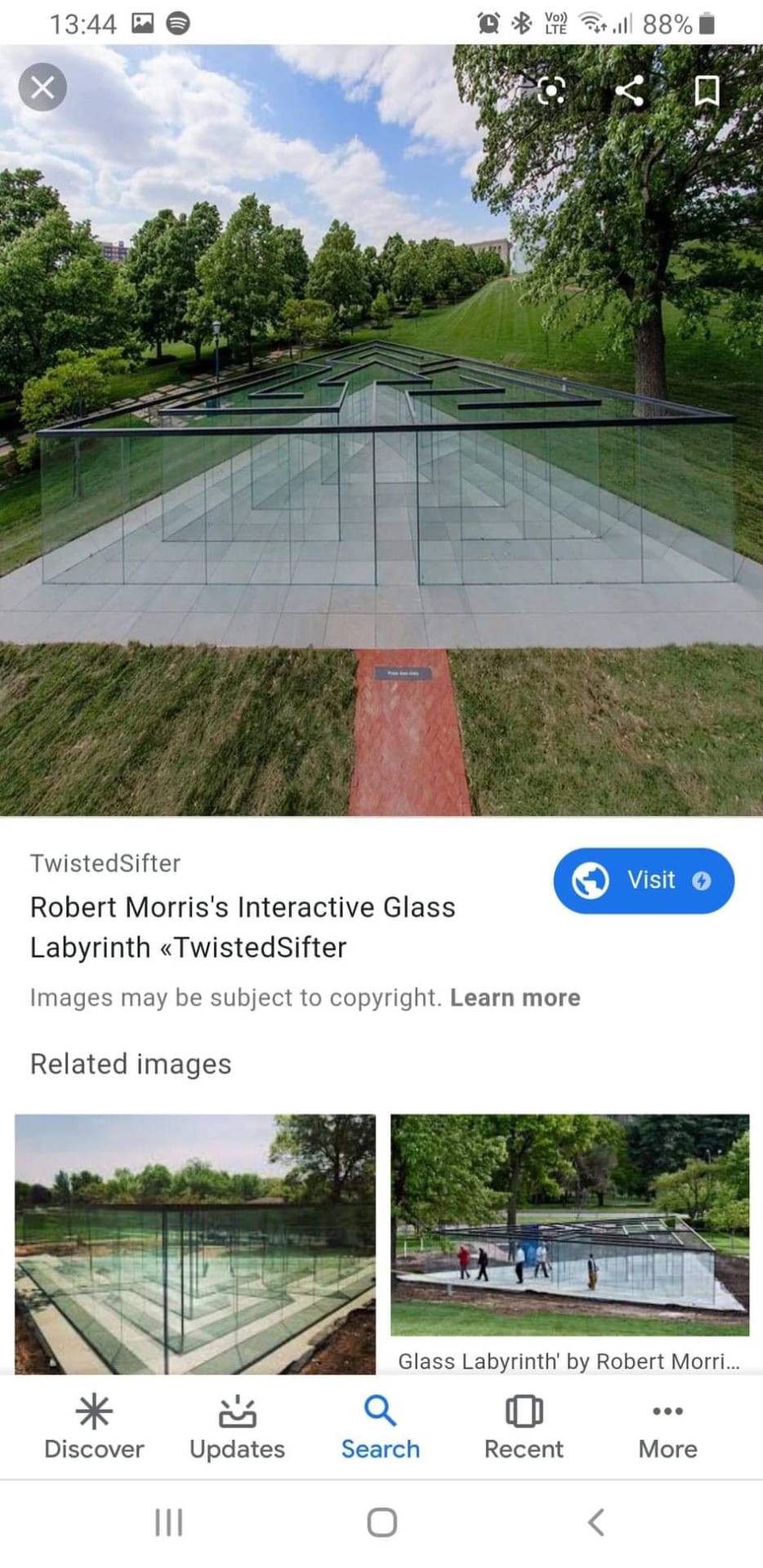
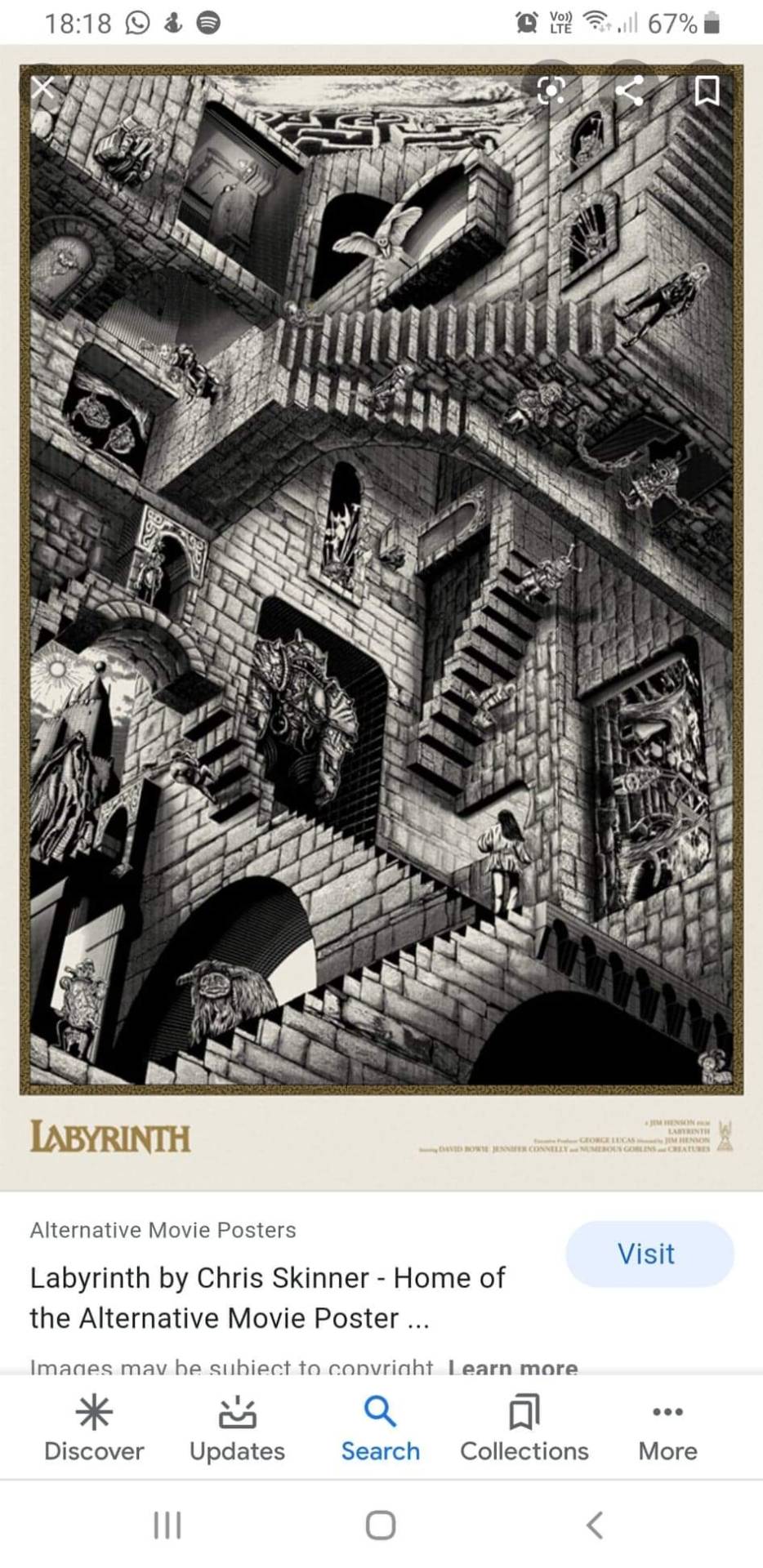
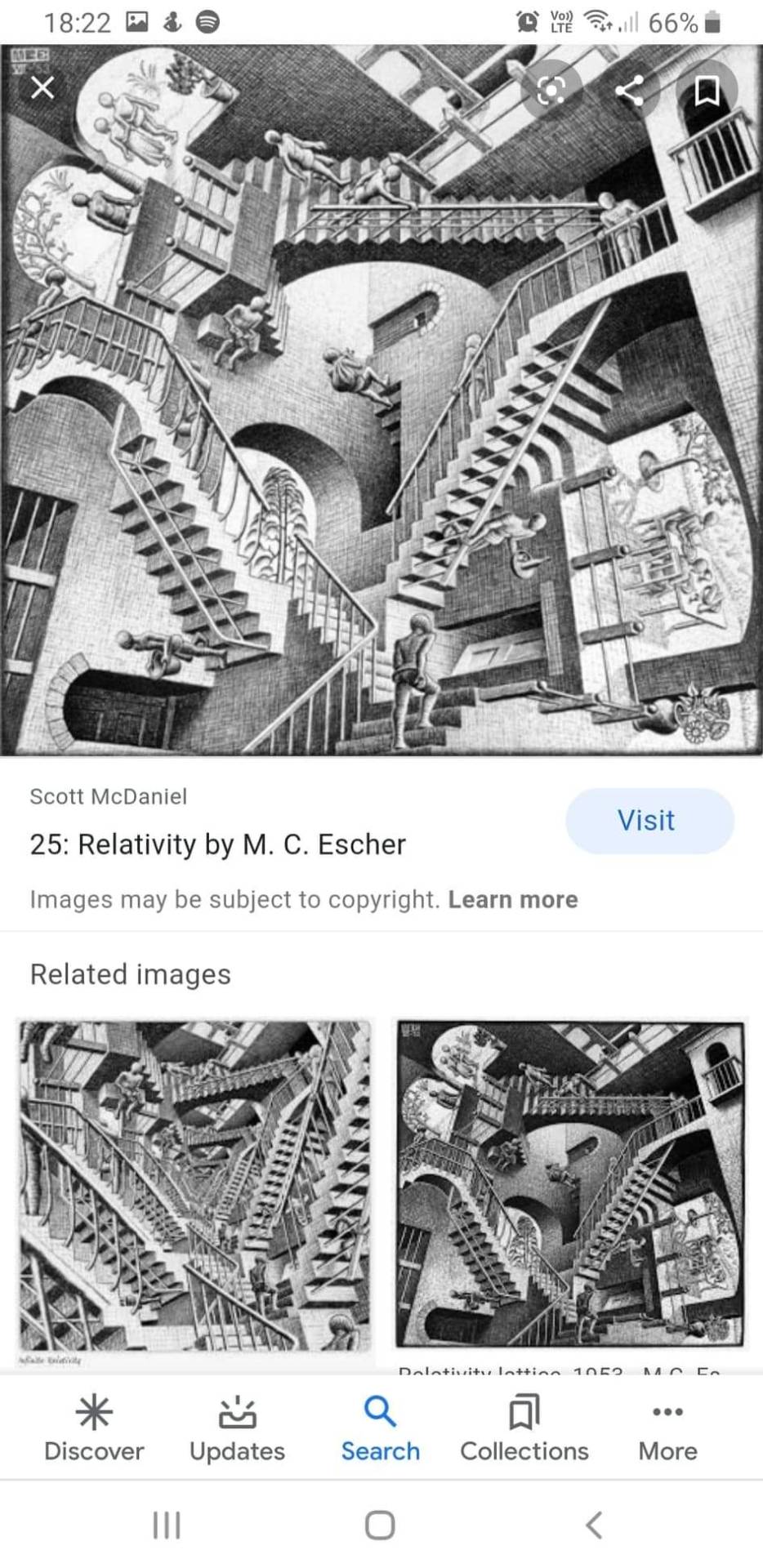
0 notes
Text
A little big confession.
I think it’s about time I got something out of my chest.
It’s got something to do with game development, but mostly with my... career.
It’s been a strange year in this aspect. I’ll put it under a read more, but long story short, everything’s fine now.
I’m dropping out from college.
After seven years trying and failing to rewire my brain into thinking like a programmer, I’ve finally come to the conclusion that programming is simply not for me.
Since I had spent some years taking “”“computer science lessons””” (read: learning to use Google, playing games, using Microsoft Word and Excel) back then, around 2006 I decided computers were my stuff. Not because I loved the idea of walking around messing with the wires and chips, or learning any programming language, but simply because I thought using a computer was Fun.
Now now, as a kid I always kept changing my life goals, I’ve wanted to be an astronaut, a cook, a teacher, a freaking singer???? Or maybe an actor. I don’t even remember. But the one and only goal in life that didn’t change was making videogames.
Back in the 90′s or early 00′s, this was a really strange dream.
“What a weird job! That’s so nerdy! That doesn’t get you anywhere! What do you even study to become a game developer!?”
So I, in all my innocence, thought it was a good idea to get into computer science. Nice! I’ll get to use the latest technology, I’ll animate in 3D, I’ll work at Pixar, I’ll-
No.
I simply deluded myself with the idea that computer science would get me where I wanted, because in Spain, or least most of the country, there isn’t such a thing as a “videogame development” career. I expected to, at least, know the basic stuff thanks to computer science, and boy was I wrong.
75% of the career is directed solely at programming, and hardware. Programming in different languages, programming obsolete ways of storing memory, programming ways of laying out and processing data, programming databases, imagining strange case scenarios that are extremely specific to the very concept you’re trying to learn and probably not even going to use in the rest of your life.
From the remaning 25%, about 15% is math. As in, boring, extensively explained and justified, and needlessly advanced, math. I personally had little to no problem with it - I passed most if not all of the math subjects in the first two years. And 10% is booooooooooooring protocols and company stuff.
Most of the time, when I thought of dropping out practically every year, there were two main fears: A, disappointing my family, and B, losing my friends. For the record, my university friends and I are still in contact, and we’re a solid squad. They were the first friends with whom I could be 100% myself.
But A, continuously failing my programming subjects made my family disappointed anyway, and B, my friends passed different subjects at different speeds, so we don’t really see each other that often in class anymore. As of this semester, I don’t share classes with any of them. So those two reasons slowly vanished and I was left in some sort of limbo where I didn’t want to keep studying, but I kept going because lol inertia.
This year, all of my subjects were programming subjects, and all of them were horribly boring and time-consuming to me. So, in order to keep my grip on reality somehow, I added a third year subject to my year: web applications development.
It’s not really about developing apps at all, it’s more about getting in touch with a few programs such as Audacity, Blender, Gimp, etc... and learning about design, cameras, file formats.
“Awesome! Something I actually know about!”
Needless to say, this subject was a freaking breath of fresh air. I had a blast every Wednesday afternoon, editing audio, learning 3D, restoring old pictures... it was fun. It was exciting. I, again, felt the joy of studying something I loved. It made me feel so excited I actually decided to make Someday v0.10, and take a short 3D modeling course for free.
The 3D modeling course was amazing. It actually made me say “THIS is want I want to do”.
Once the subject was over in February, I was brought back to reality. The rest of my year was all programming.
But that same month, one or two people began offering money for my drawings. Ever since the previous summer, I saw my family grow increasingly proud of my drawings and, heck, my work in general. They actually supported my interest in 2D or 3D art, and they recently started supporting my interest in formally learning Japanese (I’m actually looking for courses in case I can join one).
My world turned upside down entirely. And suddenly, everything came together.
I don’t like computer science.
I like all of the artistic stages of game development.
I like drawing. I like designing. I like writing stories and dialogues. I like translating. I like modeling. I like composing.
I don’t like programming, or anything about marketing.
I like art.
The idea of being An Artist is completely alien to me, though. When I was a kid, my drawings were terrible. Like, really terrible. I didn’t even like drawing. But I kept doing it. I wanted to share my ideas, my worlds, my characters. And eventually I grew to love practiically any form of art, but especially if it was directed at videogame development.
Even helping at making an animated show would be awesome to me.
This idea stuck to my mind and I actually became unable to study almost any programming at all. Every exam I would be like “I hate this. Why am I doing this?”.
It’s been rough. And hard. But it is finally time to face that by heading this way any longer, I’m not going anywhere. Even if I did finish my career, what would my job be? I’m not a programmer, simple as that. I can’t understand how I can be happy with a job where I obsessively spend hours looking for that pesky error in my absurdly long and complicated code.
What am I doing now? Well, I’m taking a similar course about computer science.
But this time, it’ll be different.
1. It’s free. I might even get a scholarship (WAIT IS THAT ACTUALLY STILL A THING THAT EXISTS?!?!?)
2. It’s in my town. No more buses or having to refill every day - we can barely afford that.
3. It’s not programming-centered at all. It’s way more job-driven, way more flexible, and it doesn’t consume so much of your time.
4. It’s just two years!
I don’t discard the idea of going back to college in the far future, but for now, I need to drop out. Student loans are huge, Java is a horrible evil monster, our education system sucks.
So, I’m almost out of college. And I’m okay, my family knows, my friends know, and they support me (thankfully). This might be the first actual summer vacation I get since 2007, with no tests waiting for me in September.
I have finally found out what I’m good at, and I want to steer my life in that direction. In the meantime, I’m still trying to earn some money with my art. My Patreon is here. (A little on the nose, don’t you think? Yeah. Capitali$m does weird thing$ to you.)
I’m pretty sure this will turn alright. This might be the best decision I’ve made in years. Better late than never.
6 notes
·
View notes
Note
❣️hoi, what was art school like? I'm planning to go myself (and my family is pretty passively aggressively turning me down), but I just want to know what skills do you learn? What is the experience? Thank u for your time! Ur blog and art are amazing btw
hI I think it really depends on the school but I can give like the idea of two of them since I went to another school for precollege to see if it was something I’d be interested in majoring in! C./C/A and I went to Ri/.ngli./.ng and my parents are actually letting me go back to school now so hopefully I’ll be back there in Fall c’: also thank you for liking my stuff!
this ask is gonna long because I know I’m gonna ramble so I’m gonna call the schools C and R so I don’t have to do the slashes all the time! C’s experience was a specific 1-2 month course so it’s nothing like actual college at R so feel free to skip down to it, I just thought it was important to add since it was my first experience at an art school
and after I talk about the schools I’ll say what stuff’s good to include in your portfolio, of course this is based on my experience but for the most part it helps in what you should try strengthening
I did animation at C, which was 2D in the morning and 3D in the afternoon. I did precollege the summer before my senior year cuz it’s like the college experience before college so you do get the feel of how it is being on your own, and I wanted to see if I was good enough to pursue something art related. At this point, my parents were on the fence about the idea, so it would help them too. And C’s in California, so I had a bunch of relatives who could show me around and who I could stay with during the weekends
experience wise, the teachers and TAs I had were really nice, so in 2D it was stuff like learning Principles of Animation and the first thing we did was a flipbook animation I think? and then it went to looking at scenes from movies for inbetweens and character sheets and we all worked together reanimating a quick scene from a movie. In the end, we all chose a really short scene from an animated movie to study and reanimate for our final
while in 3D, it was just learning around Maya and doing animation exercises each day with it, eventually working your way up to a mini film (nothing’s completely rendered though! just models), other than that it was pretty much the same as 2D
so basically, I learned the basics and they were really helpful, but to be honest I felt a bit lost with how free it was, you basically had to learn everything on your own with the teachers just checking your work. I was really good at 3D but it... wasn’t fun for me lol so I decided that after this I’d want to stay in the 2D realm of things
now for R! My parents were worried about the starving artist myth and all that, so they would absolutely not let me do Illustration even though that’s what I really wanted, so I chose Game Design and I was like hey I’ll deal with it or like maybe I’ll like it. If not, I could always try convincing my parents to let me switch my major.
the way things work at R is that all the majors are put into categories, so Computer Animation, Game Art, and Illustration are all the Media Arts majors. All Freshman take basically the same type of classes and things start breaking off around the second semester of freshman year. Eventually you like see no one outside your major lol
and lET ME TELL YOU........ R HAS A VERY HEAVY WORK LOAD, so you gotta be prepared for that. I think just about all art schools are like this, but R’s very strict on it. Manage your time wisely, there’s a lot of times I’ve seen people pull all nighters just to finish all their assignments. I was really bad at managing my time too, so when I go back I need to be more strict on myself. It’s better to do things early and relax than relax until last minute and have anxiety hell. Not many of the teachers are about how much homework you have in other classes. Also, it’s good to not do things last minute because then you can relax earlier and scanners and place you go to take photos aren’t crowded.
and trust me, your teachers will know if you did something last minute, and they can tell whether effort was put into something or not.
Now for classes, I’ll talk about just freshman year since that’s probably what’s most helpful to you right now and since I was made to drop out by my parents I’ll probably be repeating like the second semester of that rip.... anywAY
so, R starts you with foundation, so figures classes, 2D design, drawing (this one’s perspective! so important but rip everyone forgets everything after that semester so I should probably start studying perspective again)
the figure classes at R are sO GOOD............ you improve a lot with those, a few weeks into it I was thinking about the figures I had in my portfolio and was just like...... fuck these are so shitty how the hell did the school accept me.... of course the experience depends on the teacher, but I loved my figure drawing teacher he was really cool and good. He did demos at some point every class to where we would all just hover over his shoulder and watch him draw while he explained what he was doing. You i
2D design I hated because like...... abstract... it’s supposed to help you work with compositions and such but I really don’t understand abstract and execute it properly so that was a really difficult class for me
drawing class is just doing still life and perspective exercises, you don’t really get to the fun part till second semester, I forget the other exercises but I remember that towards the end there was one where you designed a car (like a fun spin on it like.... I think mine was a firefly styled car? yeAH)
other classes were Film & Narrative (so studying films, it was cool) and Writing Studio, which is just like a writing class, they don’t really apply to skills/experience in art so I’ll skip over those
second semester, you still have Figure Drawing, but there’s more of a focus on stuff and you get to draw animals too (sadly no, no real animals come into the classroom. You work off of projections and then there’s a field trip to a big cat sanctuary)
drawing II gets fun because you finally get to use photoshop for your still life and assignments, the assignments get more fun like the Tro/./.ja./n Ho//rs/e assignment. Like you could either do the actual one or draw a similar scenario, I’m totally blanking out on what I did but one of the examples was like a giant wooden mouse with cheese and in the back were cats watching the actual mice. Anyway, it had even more of a focus on compositions and colors.
Another assignment was designing a character’s room. It could be any character, but you couldn’t have anything that gave away their name. People had to be able to guess who the room belonged to just by looking at it. Sounds hard, but fun. If the character you chose had like a specific style from the concept art of where they’re from you’re free to use that too! I did Kida from Atlantis and one of my friends did Greg Universe’s room, so she got to imitate SU’s background style which was cool to see!
3/D desi/gn was............. super difficult to me, I almost failed that class >w>;;;; because it was woodshop type stuff and polymer clay depending on what you wanted. However, every assignment you did would lead up to the grunt assignment, which was like, you had three designs of things that would be possible grunt level monsters, and you essentially pitch a game idea to the class and they pick the best. SO again, modeling especially with actual clay is hard for me but it was a great experience when it came to designing and stuff. There’s more but I don’t want to get into all the assignments
3/.D design differs based on what major you’re in, and you only get it if you’re doing one of the Media Arts majors, but I’m pretty sure for the most part they’re the same?
if you major in Game Art or Animation, then you also take traditional animation, which was really fun but tbh...... I only knew how to do animation because of me being at precollege at C and then like learning stuff on my own, you were really left alone a lot, which is the same for some of the other classes. They’ll help you if you ask, but if you don’t then you can’t really get helpful feedback. Again, it depends on the teacher. The one I had was really nice and I frequently went to her for help.
so despite how some assignments/classes were hard for me, I really loved R and I’m excited at my parents giving me the option to go back, I just need to do a portfolio again >w>;;;; R’s a really good school with a lot of great resources. All of my issues came from problems with people (not teachers just other students) there and I’m not gonna get into those cuz personal lol
OKAY SO for portfolio tips
still life
figURES
ANIMALS, it makes you have a better understanding of anatomy and stuff
try to have a mix of media in there, like I mainly do digital but still have some traditional stuff to show that you know how to use those
I would keep figures realistic and not stylized so they can see that you have an understanding of them
depends on the school I think, but R strictly says in their guidelines to not do fantasy stuff like unicorns and dragons
NO FAN ART....... you can have it but you need to be really, really vague? if that makes sense, like people shouldn’t be able to tell it’s fan art
have what you’re applying for in your portfolio, so like depending on what you want I’d add concept art stylized stuff or character designs
you gotta have your best work in there, like some people like having okay/bad work to show how much they improved but that’s a bad idea, if you don’t think something’s good don’t put it in for colleges to see
11 notes
·
View notes
Text
Personal Statement
(This is what my personal statement would look like use for examples)
I chose to apply for this course because I feel it will enable me to immerse myself into the world of animation. I believe that the knowledge I will gain from the course will help me to pursue a career in 3D animation working on game and film based Projects. I hope to one day have my own animation company so I can create my own works of art.
My love for animation came to be when I was introduced to the art form of anime through Corpse Party; it’s a very dark anime but the drawings and fluency of the animation intrigued me and the freedom of this art fascinated me. I could make any scene, scenario or situation that I wanted with no limits or boundaries. At first I was practicing 2D flash stick figure animations while I worked on developing my drawing skills (an area I will continue to develop throughout my education and career). After a few years my interests expanded to 3D animations through anime related games such as Naruto Ultimate Ninja Storm. The movement, style and design of these games inspired me to learn how to make life like 3D animations and I believe this course can give me the skills I need to achieve my career, dreams and goals.
I believe I am suitable for this course because I have many of the skills required to pursue my dream and I am willing to learn new skills which I can use as efficiently as possible. I have dedicated a huge amount of time to animating in order for my work to be at the highest possible standard; I am very critical about my creations and will not stop until they are up to a standard that I see is perfect. Alongside that I can work well in a team especially when my team are as motivated as me in this subject. I have experience with Adobe Flash and 2D animations and have begun learning Maya but I want to expand my knowledge and ability to make my animations the best they can be. I also have knowledge using Illustrator, Photoshop, After Effects and Premier (the Adobe package).
The course I am doing is Interactive Media and Games level 3 and this is a course that focuses on all aspects of game creation from marketing to scripting and has enabled me to concentrate on and develop my animating skills. On this course I’ve learned valuable skills that will help me to complete the course you offer and my knowledge and practical abilities are still growing and expanding. I have personally looked into animation more deeply as that is the area of my course that I want to pursue and I am always willing to learn new methods and shortcuts to better and further my animations.
I have made my own animations at home to help practice my trade. I have also made a few animations for others for their own clips and projects that they do. Most of the animations used stick figures as they are the easiest and quickest characters to animate and I feel that that allows me to focus on the fluency and style of the animation which I had to adapt and change for the benefit of the people I have animated for.
I myself, other than animation, have a few skills which will help me with university life. First of all I have the ability to learn and understand software’s, speech and more, quicker than most. Secondly my social skills are at a point where I can work and make friends with others. I can pick up new skills and methods easily and put them into my own style and work. I can pick out when and where an animation is jumpy or doesn’t have realistic feel that a professional animation should do.
My unique ability is to keep calm, not panic and focus on the matter at hand. I rarely get stressed because I am able to keep on top of my work. I don’t get frustrated when something doesn’t go my way instead I look at different methods which will help further my projects and this can be applied to my work and personal life as well.
I’ve worked in retail and fast food. These particular jobs don’t focus on the subject at hand but it has allowed me to learn how to talk to other people effectively and it gives me experience in the working environment. I apply this new skill set to my everyday life and I believe it will help my rise through the animation industry.
When I finish this course I want to be able to go into a career in animated films and games if the opportunity should arise. My dream is to have my own animation company that combines Japanese animation stories to the 3D animated world. I aim to do this because the stories shown in these anime’s are gripping and effective but 3D animations are more accepted and viewed in the western world.
1 note
·
View note
Text
20 Games I Loved in 2016

The Switch delay. Several big AAA duds. Another year without an official Mother 3 U.S. release. 2016 could have been a disappointing year. (Outside of video games, it certainly took its toll.) But at least from my perspective, the good far outweighed the bad. Virtual reality finally made it out of the gates, and despite some hiccups, it shows real promise. Long-delayed games like Final Fantasy XV and The Last Guardian somehow made it to store shelves AND surpassed expectations. And love it or hate it, Pokémon Go inspired a genuine pop culture craze the likes of which we’ve never seen before, at least as far as games go. I think all of that is worth celebrating.
Before we get to the list, some quick shout-outs and no-brainer caveats…
2016 was not kind to the Wii U, but the 3DS quietly had one of its best years ever. That’s partly reflected here, but I couldn’t make room for Dragon Quest VII, Fire Emblem Fates, BoxBoxBoy!, Metroid Prime: Federation Force and Gotta Protectors, to name a few. Sometimes it felt like Nintendo was just cleaning out its closet — how long ago was DQVII released in Japan? — but we benefited either way.
Overall, I played fewer games this year, but the ones I did play held my interest longer. Thanks to various microtransactions and DLC, 2016 probably hit my wallet just as hard.
What didn’t I play? Stardew Valley, SUPERHOT, Final Fantasy XV (at least past chapter 2), Frog Fractions 2, Hitman — oh, and I didn’t get to stuff from last year like Yakuza 5 or The Witcher 3, either. Yakuza 4 was pretty solid though.
I left off any new ports of games that came out last year or prior, unless there were substantial additions that changed the experience in a meaningful way. That meant The Legend of Zelda: Twilight Princess HD and Mini Metro weren’t in the running, while Rez Infinite technically was.
Love making lists, hate ranking items in said lists, just because I’m incredibly fickle. There’s a good chance that I’ll want to shuffle everything around the moment I publish this. But my podcasting buddies are counting on me here, so it’s time to be decisive.
Keeping all that in mind, here are the games I really loved in 2016…
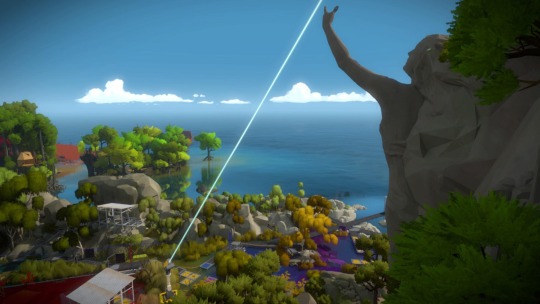
20. The Witness - I’m already cheating because if I’m being honest, I didn’t actually love this game. The Witness takes a couple dozen hours to finish, and I spent at least half of them staring at a notebook, drawing grids, connecting dots, and having no idea how to pave forward. But even if I didn’t love the game, I respect it immensely. I admire Jonathan Blow’s commitment to this singular idea, of taking the kind of puzzle you might see on a restaurant placemat and coming up with every possible permutation of it. And there is of course a “meta” layer on top of that, where solutions to each component change the environment around you — tree top bridges that unfold based on the paths your lines take, or colored glass panels that create new puzzles on top of old ones. It might be cold and off-putting at times, but The Witness is still commendable as the ultimate puzzle box.
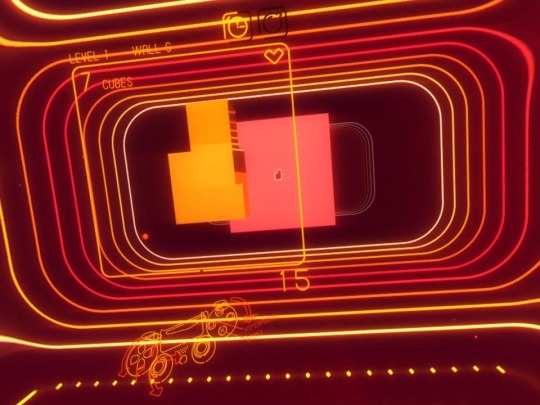
19. SuperHyperCube - I bought into PlayStation VR for games like Rez Infinite and RIGs — big, flashy, “immersive” experiences. And they delivered! I’m a very happy PS VR owner, and I hope Sony builds on its momentum this year. (I’m skeptical, but then being a virtual reality early adopter was always a leap of faith.) However, while I got exactly what I expected from most of the launch titles, it's the simple puzzle game seemingly modeled off of “Brain Wall” that I keep coming back to. I turn on the headset to play Job Simulator or Battlezone, but I always play a couple rounds of SuperHyperCube before I’m done. A solid case for virtual reality not as a thrilling roller coaster, but a hypnotic, relaxing voyage.
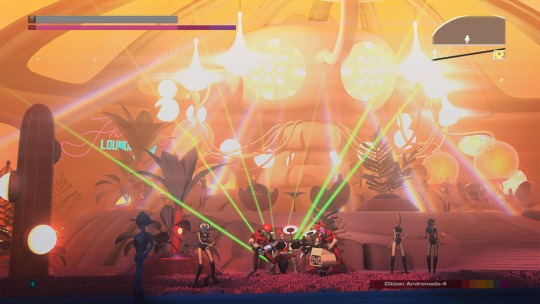
18. Headlander - The best game Double Fine has put out since Iron Brigade. Free-roaming Metroid-style exploration, a perfect 70s-synth sci-fi score and a fun body swapping gimmick at the heart of it all. I wish there were more vessels for your noggin to control, but there’s a strong foundation here.
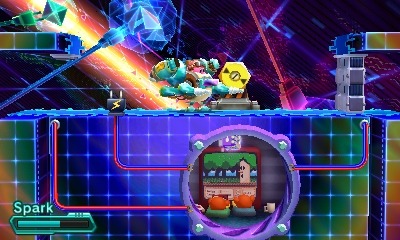
17. Kirby: Planet Robobot - It’s easy to take Kirby games for granted, and that’s especially true of Robobot, which uses the same engine and many of the same powers as the recent Triple Deluxe. What does the former bring to the table then? Smart level designs that take advantage of the new mechs without letting them dominate the action. A novel mechanical world that feels distinct from the typical pastel meadows. New amiibo support. OK, so maybe it doesn’t add that much to the series, but it’s right up there with Super Star anyway.
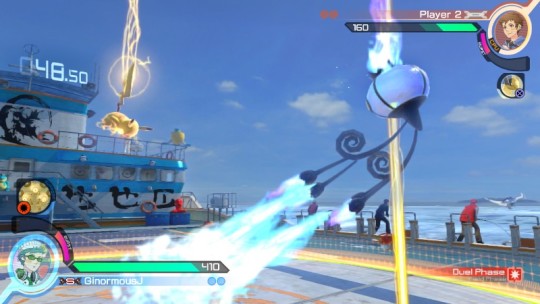
16. Pokkén Tournament - This game is a fresher, more enjoyable fighting game than Street Fighter V. It doesn’t even matter (too much) that the single player is pretty thin or that the roster is small. When’s the last time you played a one-on-one fighting game that felt truly new? Pokkén is a great 3D fighter and a great 2D fighter at the same time, which is no small feat. And it’s also a gorgeously animated recreation of those battles we all imagined happening in our Game Boys 20 years ago.

15. Uncharted 4: A Thief's End - The popular sentiment seems to be that Madagascar is when this final Uncharted entry really takes off. Slow drama and frequent cut scenes give way to island exploration and memorable shootouts. My take? The back half is fun and the epilogue is lovely, but I could spend an entire game in Nathan and Elena’s living room, or hopping around the globe for the next story sequence. Wherever you stand, this is a fine way to close out a reliable series.
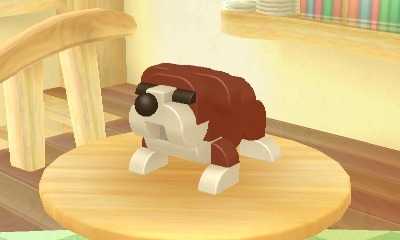
14. Picross 3D: Round 2 - Seven Picross games — eight if you count the Twilight Princess freebie — on the eShop. That’s a lot of a perfectly fine thing. But none of them are Picross 3D. Thankfully, the real deal finally arrived this year, with hundreds of puzzles and a few extra gameplay wrinkles. Worth the premium price tag.

13. Titanfall 2 - The campaign didn’t need to be good. Multiplayer FPS games live and die by their multiplayer, and many developers seemingly write off the single player experience as an afterthought. That’s why Titanfall 2 is such an unexpected treat. The factory, the time hopping, the airborne carrier — all cleverly designed, with platforming gimmicks that would feel just as suited for a Metroid Prime game. I think the reason the new Mirror’s Edge fell flat for me was that this game featured the same parkour moves in a much more exciting package.

12. Tokyo Mirage Sessions #FE - This crossover game is Persona-lite, yes, but I think that sells the characters and world a bit short. While its inspiration focuses on the pressures of being a Japanese high schooler, #FE is all about the Tokyo show biz scene. Pop music, soap operas, microwave cooking shows — it’s all very goofy, but the game still takes its protagonists’ dreams and ambitions seriously. #FE also makes clever use of the Wii U GamePad, turning it into a tablet/social app that helps keeps the conversations going. Even if you’re not into this particular “scene,” #FE may still win you over.

11. Rhythm Heaven Megamix - I can’t get enough Rhythm Heaven. They could put 20 new musical minigames on a cart annually and it’d make my list every year. Sumo wrestlers, lumberjack bears, monkey slumber parties — all magic.

10. Severed - A Vita game! It’s great to see DrinkBox Studios stretch beyond sidescrollers with this first person dungeon crawler full of grotesque monsters and creepy, colorful mazes. Swiping and poking on the Vita’s touchscreen feels great. The controls are key to Severed’s success; if battles were menu-driven, the entire game would fall apart.
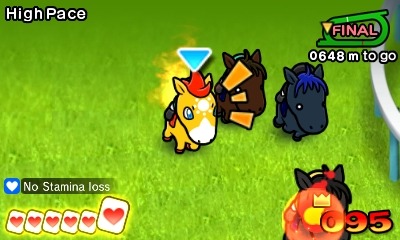
9. Pocket Card Jockey - I hope Nintendo keeps letting Game Freak be this weird. It’s not just that it’s horse racing plus solitaire. It’s your jockey biting the dust and being brought back from the dead to repay his debt to the angels. It’s the brassy, big band score that accompanies every race. It’s horses with luchador masks and cats hanging from their backsides. Pocket Card Jockey is a miracle of localization.

8. Pokémon Sun - Yes, another Pokémon game. The Alola region is the best thing to ever happen to this series. Previous games had regions based on cities like New York and Paris, but the results always felt half-hearted. In Sun (and Moon), the tropical island setting influences everything from the creatures you catch to the trials you complete. I’ve never demanded a believable world from this series, but that’s kind of what we get here, and it’s terrific.
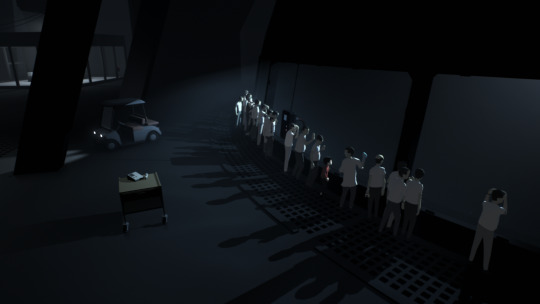
7. Inside - This is the type of game where the less you know going in, the better. It’s Limbo — a previous Justin GotY — filtered through a twisted dream logic that I still can’t get out of my head months later.
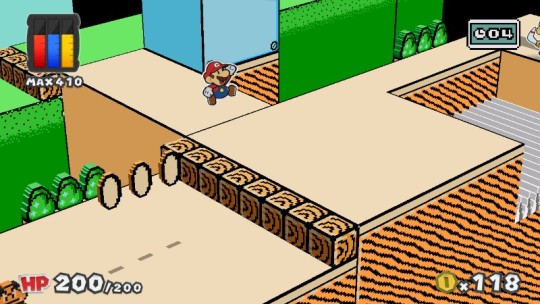
6. Paper Mario: Color Splash - I know you don’t like Sticker Star. Rest assured: that 3DS oddity feels like a rough draft for Color Splash, which improves upon its predecessor in every way. A textured, vibrant world that rivals Tearaway in its papercraft. Thrilling scenarios like a train heist, an underwater game show and the throwback above. Hilarious dialogue that mostly makes up for the many, many identical toads. I miss the liberties Intelligent Systems used to take with the Mushroom Kingdom, but everything else about Color Splash restores this spin-off series to its former glory.

5. Overcooked - This year’s couch co-op champ. Cooking with a partner is all about communication, and that’s doubly true when the kitchen is split across two flatbed trucks or on an iceberg rocking back and forth. My friends and I love head-to-head games like Smash Bros. and Towerfall, but it’s nice to play a game that’s all about puzzle solving and careful planning together. And I love the wistful stage select music.

4. Dragon Quest Builders - Minecraft has always fascinated me, but I don’t do well without direction. That’s why I’m so grateful for Dragon Quest Builders, which breaks down the open world construction into small, manageable tasks. I started off just sticking to blueprints and keeping decorations to a minimum; now, I’m spending hours building up towns the way I want them to look, for no other reason than my own personal satisfaction. Even taking the crafting element out of the equation, Builders does a great job of capturing the adventuring spirit of its parent series.

3. Pokémon Go - I didn’t set out to put THREE Pokémon games on here, and in a vacuum, this is much less satisfying than Pokkén or Sun. But we don’t play video games in a vacuum, and certainly not this one. I played Pokémon Go in Central Park, talking to strangers to find out where the Ivysaur was hiding. Or I played on my lunch breaks, exploring parts of South Street Seaport with coworkers that I had ignored for years. Go’s peak came and went, but it remains one of my fondest experiences of the year.
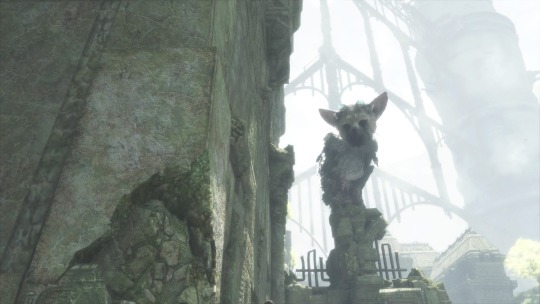
2. The Last Guardian - Another game that’s more than the sum of its parts. The Last Guardian is finicky and sometimes frustrating. Trico is hard to climb. The camera doesn’t know what to do when you’re up against the wall. So what? How many games feature a creature this lifelike? He may be an illusion made up of A.I. routines, scripted animations and fur shaders, but all of those elements come together in a uniquely convincing way. His evolution from reluctant ally to friend has a subtlety I’ve never seen before. I’m glad Ueda spends as much time focusing on the inner struggles as he does the external ones. Hope it doesn’t take another decade for his next game.
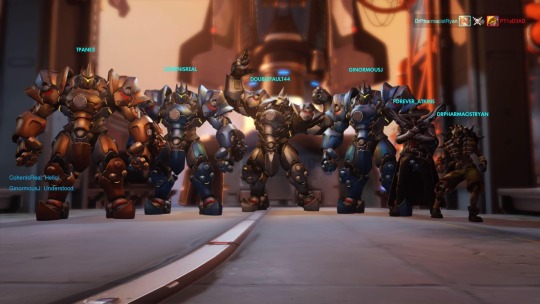
1. Overwatch - I didn’t even know what Overwatch was until two weeks before its release, and even then, I didn’t expect much from it. I had played Team Fortress 2 and thought it was just fine. I knew what to expect. Medics, tanks, builders — that sounded familiar to me. But I was so wrong. Overwatch isn’t just a team-based shooter; it’s the superhero team-up game I’ve been longing for since “The Avengers” was in theaters.
All 23 (and counting!) heroes have their superpowers, and all of them have their jobs to do. What really sets Overwatch apart is when these heroes are bouncing off of each other. Any combination of six is going to have its own dynamics. Mei dropping ice walls to give Reinhardt time to recharge his shield. Junkrat dropping traps to help Bastion watch his back. Mercy gliding up to Pharah to give her rockets a little extra punch. Every battle brings new possibilities and strategies to the table. I’ve played over 100(!) hours and feel like there’s still so much to learn.
But it’s not all serious business either. The colorful personalities, animations, costume designs and more do so much to shape the world, even when I know next to nothing about the overall “lore.” Last year, Splatoon felt like the only shooter I’d ever need, but Overwatch has actually managed to supplant it in my heart. That’s something this Nintendo fanboy never thought he’d say. Can’t wait to see how Blizzard builds on their masterpiece in year two.
3 notes
·
View notes
Text
Artist Research
Scott Robertson
About:
Scott Robertson is an American concept artist, known for his transportation design work. He is a design consultant for the entertainment, sporting goods and transportation industries. He attended the Art Centre College of Design, where he graduated with a honors and a B.S degree in transportation design. With 18years experience of concept design under his belt he created a curriculum on how to design, draw and render to the highest college level bringing out his own books and education videos featuring his own lectures of design making. He has worked for a variety of professional companies including; Hot-wheels, Universal Studios, BMW, Nike, Rockstar games and Sony.
Style:
A lot of his work consists of very detailed mechanical concepts based on transports, robotic structures of the future. His style is very tight and precise in order to create proportional 3d and 2d concepts that look realistic and like they could soon exist. After looking at a wide range of examples of his work I managed to depict a method which he uses quite frequently in order to create his interesting concepts. His method consists of using a light coloured marker pen to create a flat structured composition which he then works into using a fine-liner pen to add details and extra parts.
What inspired me:
Straight away after looking at Robertson’s designs I was drawn by the level of detail using line work which he develops into his imaginary concepts as well as the quality of his drawings to seem so realistic due to his proportion and perspectives. I was also inspired by his method he uses in his work by starting by simply sketching a rough, random compostions that he then works over the top of in line work.
This method allows you to follow a structure rather than coming uo with something completely from scratch whilst trying to make it detailed and precise which can be very hard.
Takeaways/potentials:
In my next steps I would like to explore Robertsons technique of using a light coloured marker pen to create a basic structure which I could then work into.
Use a light coloured marker to create body shape eg. arm, leg which I could then work over the top of, adding mechanical/technological parts to create bio-mechanical concepts.
Longque Chen
About:
Longque Chen is a American concept artist from Pasadena, USA. He began in 2015 as a freelance designer, designing mech, props and vehicles, he then went on to work with various companies creating concept art for a range of films and video games.
Style:
A lot of his work consists of sketches/concepts of imaginary characters, weapons, landscapes and vehicles. As well as these, he also creates a range of work based on the theme of bio-mechanics, sketches include existing animals which have been given a mechanical approach. By doing this he creates a range of machine like animals used in video games as weaponry and defence, adding mechanical, robotic parts to enhance their abilities making them more effective.
He creates these concepts in a very realistic manner, being seen from a range of different perspectives with immense details to seem as realistic as possible. He starts by sketching out the animal he is manipulating with, he will then begin to sketch around several ways he could re-create body parts in a range of mechanical ways. Eventually he will refine a final design after experimentation of how areas could be manipulated in a number of alterations.
Themes in his work include bio-mechanics, alteration, manipulation, enhancement in order to re-create animals, scenery, weapons, vehicles which all are designed from a reference.
What inspired me:
Looking at Chen’s work I was inspired through his theme of bio-mechanics which I decided to explore further in this project thinking about how I could replace human parts with mechanical enhancements. In his work he looks at the combination of animal anatomies with mechanics however I will be looking at human anatomy and mechanics/technology.
Takeaways/potentials:
Start by sketching out human body parts which I can then work into and re-create as reference using mechanical/technological parts.
Create a concept using line work of a fine-liner to create a precise, detailed outcome.
Ash thorp
About:
Ash Thorpe is a illustrator, graphic designer and creative director for feature films, commercial marketing and print. With a exceptional style of his own, he quickly gained recognition among the industry, most notable for his role as graphic designer for Ender’s game and Total Recall which he create user interface graphics and design content for. He also contributed to the direction and concepts for Prometheus, Xmen: First class, The Amazing Spiderman 2 along with many more well known titles.
As a designer, he has created a range of different graphics showing a broad range of style, processes, methods including Dawn Of The Planet Of The Apes, to his UI design elements for films and games like James Bond - Spectre and Call of Duty - Advanced Warfare, Thorp has played a major role in the art direction and creation of many of the creative visuals that we’ve come to know and love in entertainment.
Style:
One series of work by Ash Thorp I found very interesting is his ‘Lost Boy’ series, in this he was attempting to re-connect with his child-like self. As a child he was obsessed with comic art and used to sit there hours on end sketching and drawing from his imagination. He began this series by sketching inspired by things he enjoyed as a kid and growing up in the 80′s eventually becoming obsessed and ended up creating over 500 pieces of work. The idea of Lost Boy was born years back by Ash Thorp’s passion for sketching out these unique characters and scenarios. He was inspired by things he enjoyed as a kid and growing up in the 80′s becoming obsessed and creating over 500 pieces of art, which quickly gained a huge fan base. Thorp soon ended up sharing his art with Anthony Scott Burns where they started to evolve the drawings into a series with a fascination storyline and uncompromising vision of society’s far distant future sure to surprise audiences.
Within this series, Ash Thorp created a wide range of designs of different characters, these were created through drawing which he then developed digitally into book covers and poster designs.
What inspired me:
Within the artworks produced by Ash Thorp I was really interested in the crossover of medias creating some really effective, eye catching illustrations. Initially the designs were created by the process of drawing using a pencil, building up detail and tone to explore perspective making them seem realistic. Once he was happy and created solid drawings he has then edited them further in order to darken and add minimal amounts of colour, over the top of the illustrations he has then added some text digitally. Overall I think the cross media works really well in order to create a contrast between the detailed, ‘sketchy’ hand-rendered drawing and the clean, solid digital text which could be used as a book cover or poster.
This is something I would like to explore within my final outcome, creating a illustration by hand which I can then experiment and manipulate digital, also thinking about the application of text.
Another factor, that caught my eye in these artworks is the use of the bold black and white illustration which is brought to life by the eye catching solid red text which sits on top.
Potentials/Takeaways:
Use the crossover of media, create something hand-rendered which I can scan in and develop digitally.
0 notes
Text
Mini Games.
Play your method through classic games, from Pac-Man to Super Mario Kart. Have a look at 22 of the most significant and best looking new video games pertaining to PS4, Xbox One and Nintendo Change in 2018 and beyond. Dragon Ball Z: V.R.V.S. is a combating dragonvale world hack game released in 1994 for the Sega System 32 game platform by Sega and Banpresto Although the game is in 2D, it utilizes camera angles positioned behind the characters to develop a 3D-like experience.
If you are a fan of tactical games then this is one of the most fascinating games you might grasp on Android. Steam is the finest place for you to hunt for new dragonvale world cheats if you're keen to get into PC gaming. Our Dragon Ball games are divided into classifications for your convenience. Take a look at our 2 Gamer video games category - where if you search well, you'll find games for as much as 4 players.
If you are a late 90's kid, or an early 2000's, then it is safe to state that you know Nintendo's fantastic Video game Boy Advance This handheld console was an action up from the Gameboy Colour, allowing the players to enjoy dragonvale world guide the best GBA games without any issues. The most remarkable feature of Dragon Ball FighterZ - from the 2nd you boot up the game - is how it looks.
However, Layers Of Worry is Aspyr's very first original video game, and was established in combination with Polish designers Bloober Group, who declare to specialise in 'mental horror video games'. In addition to physical games, likewise provides a wide Dragonvale World guide range of digital games available to download instantly. Isometric role-playing video games like Baldur's Gate do not suffice in the AAA world anymore, however Pillars of Eternity revives their essence for the Steam crowd.
However that doesn't mean it won't be an enjoyable, commute-friendly option for fans of the exceptional Dragon Ball FighterZ - and a decent stab at doing justice to the source material. Some great games are flying under SteamSpy's radar because Dragonvale World cheats they're either current or not selling well. You'll find some of the very best video games to play in 2018 in the top of half of the short article and some of our long-term favourites nearer the bottom.
This is a video game that's certainly worth checking out if you remain in one of the nations where it's been soft introduced, and a video game to watch on if you're a fan of Supercell's previous video games like Clash Royale and like action-packed dragonvale world cheats like this. I love Spiders-- the developer, not the arachnids-- because even though its previous RPGs have actually been cumbersome, buggy, and underdeveloped for their size, the undaunted ambition in each of its games is admirable.
It was my dream to work in the video games market and Coventry was among the couple of universities offering a course in this location. The game includes 27 playable characters, their sprites being those used in an earlier Dragon Ball Z video game, Dragon Ball Z: Ultimate Battle 22. Its story mode ranges Dragonvale World guide from the Android arc to the Cell Games. 2, Doragon Bōru Zetto Sūpā Butōden Tsū, Dragon Ball Z: Super Combating Story 2), called Dragon Ball Z: la Légende Saien in France and in Spain (although it was translated as Dragon Ball Z: La Leyenda de Saien for the Spanish user's manual), is the 2nd installment in the Super Butōden series.
After you have actually set up the Steam Customer, developed a Steam account and logged into the Steam Client using that Steam account you can activate your video games. Thats an embarassment, it'll be another 2 years prior to i get a good enough mobile to in fact play games on it. Kinda draws living dragonvale world hack in 2 countries during the year. With PlayStation VR, HTC Vive, and Oculus Rift out together with less expensive headsets like the Samsung Equipment VR, Google Musing View and Cardboard, you have yourself a substantial choice of both high-end and mobile video games to select from.
By default, Steam sets up the games in your library alphabetically. It's one of the upcoming PS4 video games of 2018 we're anticipating many. The course aims to establish crucial competencies in technical video games production, critical analysis, application of principles and theories to real-world scenarios, localisation and digital literacy. For those who pre-ordered the video dragonvale world hack game this game through Amazon would receive an email with a code to download the Japanese version of Dragon Ball Z: Super Butoden 2 They would also receive 6 extra Z Help assistance characters via an extra code sent out a few days following the video games release.
The initial title for Infinity OPS provides you a clear concept of the setting, visual, and gameplay design the developers were choosing, and they've been mainly effective in reproducing the frenzied action and remarkable area dragonvale world guide settings of video games like Fate and Halo. I have not kept up with the new Dragon Ball Super TELEVISION program, and I haven't. earnestly played among the video games completely because the PlayStation 2 age.
0 notes
Text
KILL la KILL - IF Is Heavy On Depth And Light On Content
If you’re a fan of Studio Trigger, you’re probably well aware that an important date is fast approaching. In just a handful of weeks, it’ll be October 4th once again, marking six years to the date since Trigger began airing their first full-length television anime: Kill la Kill. Combining the talents of established creators and young talents alike, this project took the anime world by storm and put the fledgeling studio behind it on the map. It remains an incredibly popular entry in Trigger’s growing catalogue of international hits, though many fans lament the fact it was never continued past its first and only season.
Admittedly, I was never one of them. I had gone into the show with high expectations for it and couldn’t help but feel sadly let down by the end. So when I found out that a Kill la Kill arena fighter for the PS4, Switch, and Steam was in the works, titled KILL la KILL - IF, I initially had no interest. That is, until I found out it was being published by none other than THE Arc System Works, rulers of the anime fighting game scene. With the likes of BlazBlue, Guilty Gear, and Dragon Ball FighterZ under their belt, they can hardly do wrong in the fighter department. Sure, they may have merely published and oversaw development at A+ Games, and it is a 3D arena fighter opposed to their usual 2D fighting specialty, but make no mistake: KILL la KILL - IF feels like an ArcSys game through and through.
Upon starting KILL la KILL - IF for the first time, you’ll find yourself immediately forced into playing “episode one” of the game’s story mode. The story mode places you in the role of none other than Satsuki Kiryuin at the conclusion of the Naturals Election. Facing off against series protagonist Ryuko Matoi, this first mission acts as your basic tutorial for the game, and completing it will unlock Free Battle as well as a few other modes, though you’ll need to progress further in the story to unlock all of them.
Regarding the story, I have good news and bad news for Kill la Kill fans. The good news is that this story mode isn’t a simple retreading of the show’s story. It’s a new scenario written out by the show’s original screenwriter, Kazuki Nakashima, offering an alternate series of events offshooting from the dramatic turn that takes place during the Cultural and Sports Grand Festival in the show. You also play as Satsuki for the majority of this storyline, offering by far the show’s best character a much-deserved spotlight.
The bad news is that, unfortunately, it isn’t very good. If there was one thing I liked about the show, it’s that it had tremendous style to it ― a style that the cutscenes in KILL la KILL - IF completely fail to emulate. They try, sure, but the result is just incredibly awkward. Watching a flat cel of a character cartoonishly fall off the stage at a 90 degree angle is funny in 2D. Watching the same exact thing happen to a 3D model is just ugly.
If that isn’t bad enough, there’s barely any actual story in this alternate telling of events. The story lasts a handful of hours, and most of the cutscenes you’ll see are just various characters finding any reason they can to fight each other. It completely lacks any fanservice. No, not that kind, the other kind. The kind that fans want out of seeing the characters they obsess over interact in new situations. KILL la KILL - IF’s story has next to none of that, if any. At best a character will get a very archetypical line or two before fighting again. While I’m at it, there is in fact less fanservice fanservice than in the show. Characters are now shown in underwear where they were once buck naked, so there’s that, too, I suppose.
Another glaring issue in the game is a disappointing lack of content. KILL la KILL - IF features only eight fighters: Ryuko, Satsuki, the Elite Four, Nui, and Ragyo. Admittedly, this shallow roster is to be expected from a licensed property with a mere 24 episodes to its name. But still, it wouldn’t be impossible to pick out a few minor ones from the Kill la Kill canon. As far as I’m concerned, it’s completely inexcusable that Fight Club Mako didn’t make the cut. I’d much rather play as her than any single member of the final roster.
The stage and alternate color palette limitations are also felt to a lesser degree. There are only six stages in the game, most of which feel and look a lot like one another. Again, this is mainly a problem stemming from the source material. Kill la Kill also suffered from a lack of variety in its environments. That being said, the lack of alternate color options for characters is rather baffling. Each character has their default look, an alternate look based on the show’s OVA, and their own unique palette swap based on popular ArcSys characters. With a confusing lack of options in the game, one would expect them to be selling more as DLC, but that isn’t the case either.
Now, all of that’s pretty negative, but don’t start removing the game from your wishlist just yet. While KILL la KILL - IF does fail to deliver on the Kill la Kill fanservice-y side story shenanigans fans of the show might want, it’s still a game that comes courtesy of Arc System Works, meaning it is a fantastically fun fighter from the moment you pick up the controller.
The mechanics are incredibly simple to pick up. You have a melee attack, a projectile, and a guard break to attack with as well as special attacks that can be activated once your SP meter fills. When certain conditions are fulfilled, you can activate your Bloody Valor, a head to head rock-paper-scissors-type battle that can award different buffs to the winner while dealing damage to the loser. There’s also a guard button for defense and a jump button that can be used to dash in different directions relative to your opponent.
These are, all things considered, pretty simple mechanics. However, there is a tremendous amount of accessible depth to this game’s combat. There are a myriad of different combos that can be strung together from these options. All of them are spelled out clearly and succinctly in every character’s Command List along with very helpful information about each character’s specific strengths, weaknesses, and how they’re meant to be played.
Though the roster may be small, there is a lot of diversity in playstyle from character to character. Gamagoori’s damage output rises the more damage he takes, and he can self-inflict damage to complement that. Nui is a highly technical character best utilized in air combat. Nonon utilizes strong projectile attacks but sports less options in close combat. Each character feels different to play as and must be approached differently when played against.
The only persistent complaint I have about the combat is the camera. The player has no control over the camera. It instead revolves around your opponent, meaning that if your opponent is backed into a corner, you can find yourself facing your character further away but still having to control them as if you are looking behind the back at them. Additionally, certain attacks or characters can outright block your view of your own character. This can lead to situations where you have no idea if you’re being combo'd at all or not.
Camera issues aside, if any of that sounds interesting to you, you better hope you have some friends to play against because the online scene I experienced on PS4 was dead as a doornail. After spending all night plugging away at the story, I went to bed excited to wake up the next day, find a character whose playstyle I liked, and hop online to try them against some real people. When the time came I hopped into Free Battle and began looking for a room.
Nothing.
I furrowed my brow and tried again. Nothing.
I went through all the room search parameters to make sure I cast as wide a net as possible.
Still nothing.
Baffled, I checked my internet connection. No problems there. There wasn’t a single lobby to be found for non-ranked matches online. I created my own lobby just to see if there was anyone out there. I waited, and waited, and waited. TWENTY MINUTES LATER someone finally connected. I played three matches with them. I went decisively 0-3.
Ranked battle was a slightly different story. I immediately connected with another user and was again demolished, this time by both my opponent and some of the worst lag I have ever experienced in an online game. After declining their rematch, I sat and waited for another to come along. No one ever did.
It was a real gut check moment that halted all of the enjoyment I’d had playing KILL la KILL - IF. As someone who enjoys playing competitive games, there’s little enjoyment to be had from playing against AI-controlled opponents. It can help you get the basics down, but you won’t be able to play at a higher level unless you’re testing yourself against actual people. KILL la KILL - IF’s online scene is barren, so without a circle of skilled friends to play against, your only option is enduring excruciatingly long matchmaking times only to be matched up with opponents who probably have terrible connections.
It’s truly unfortunate. There’s a great game to be found within KILL la KILL - IF, but it’s being held back by the very property it’s based on. The pool of reference the developers had to draw from in Kill la Kill was just way too shallow. Not to mention that though the series may be popular, it’s nowhere near as iconic or identifiable as its licensed counterparts in the 3D arena fighter genre. The overlap between ArcSys fans, Kill la Kill fans, and 3D arena fighter fans was just way too small. Arc System Works and A+ Games delivered a really solid fighter ― here’s hoping they can do it again with something a bit more marketable.
REVIEW ROUNDUP
+ Accessible, satisfying combat with a high skill ceiling
+ Gorgeous combat animations ArcSys fans know and love
+ Thorough, easy to understand Command Lists
+/- Unique playstyles for every character, but an incredibly limited roster
- Limited content and callbacks for Kill la Kill fans to appreciate
- Seriously, they didn’t even include Fight Club Mako
- Disappointingly boring story mode
- Wonky camera positions mid-battle
- Online scene is dead-on-arrival
Are you a Kill la Kill fan excited for KILL la KILL - IF? Have you already played the game? Let us know how you feel about it in the comments below!
-----
Danni Wilmoth is a Features writer for Crunchyroll and co-host of the video game podcast Indiecent. You can find more words from her on Twitter @NanamisEgg.
Do you love writing? Do you love anime? If you have an idea for a features story, pitch it to Crunchyroll Features!
0 notes